Nature’s great, but it’s not as nurturing as most people seem to think these days. There’s a reason humans latched onto the dormant conveniences of modern life, and anyone who’s had to spend a rainy night in the wilderness after going a day or two without food is very familiar with that reason.
With that in mind we will continually update this article with our favorite survival knife picks as we test new models.
Our Favorite Survival Knife Picks
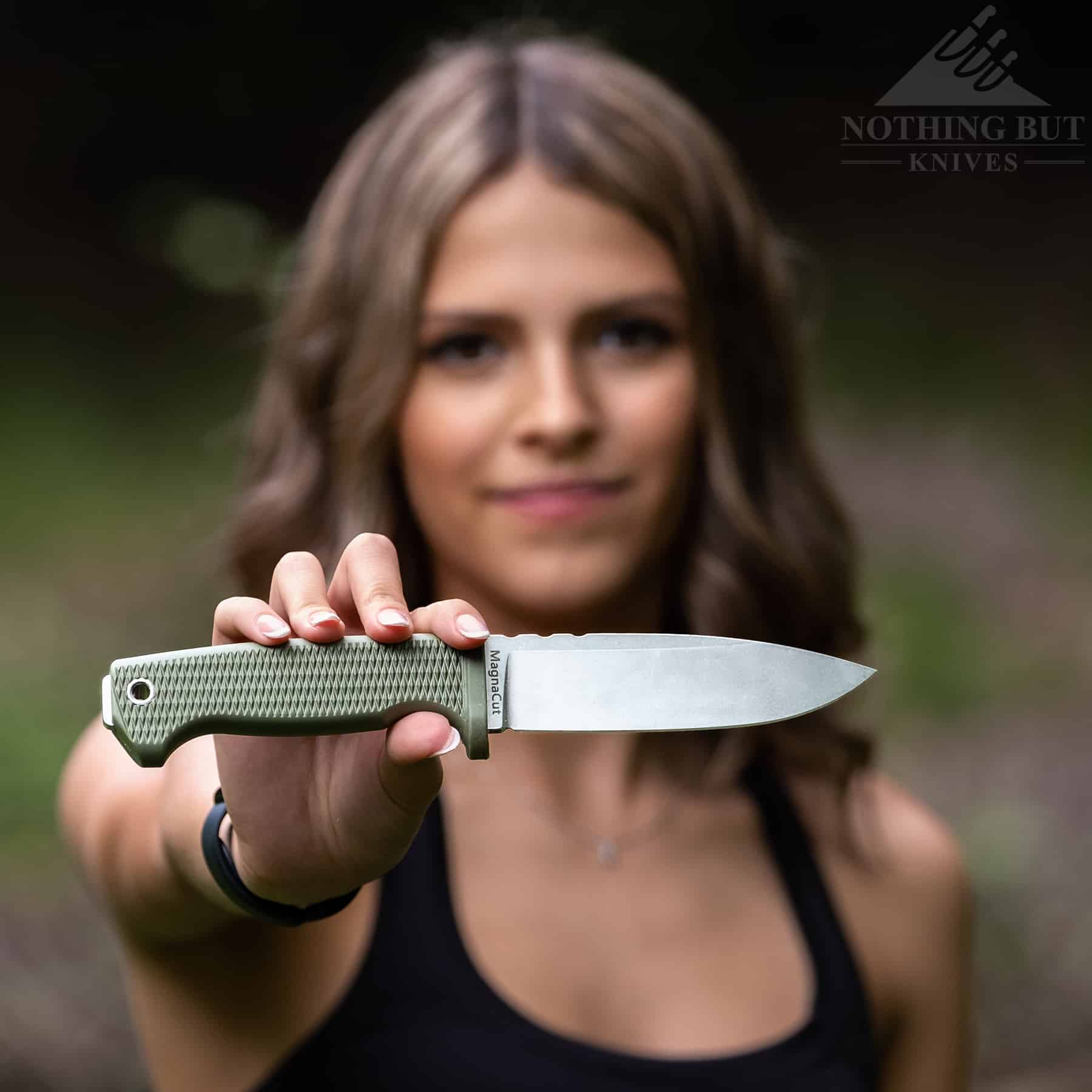
It’s not that nature always wants to kill us, but on the whole it doesn’t care whether you live or die. This is as true in 2024 as it has ever been. Sometimes you need to pack a decent knife to make it care, so we tested a few knives with that in mind and put our favorites up here.
Survival Knives We Tested and Like, Alot
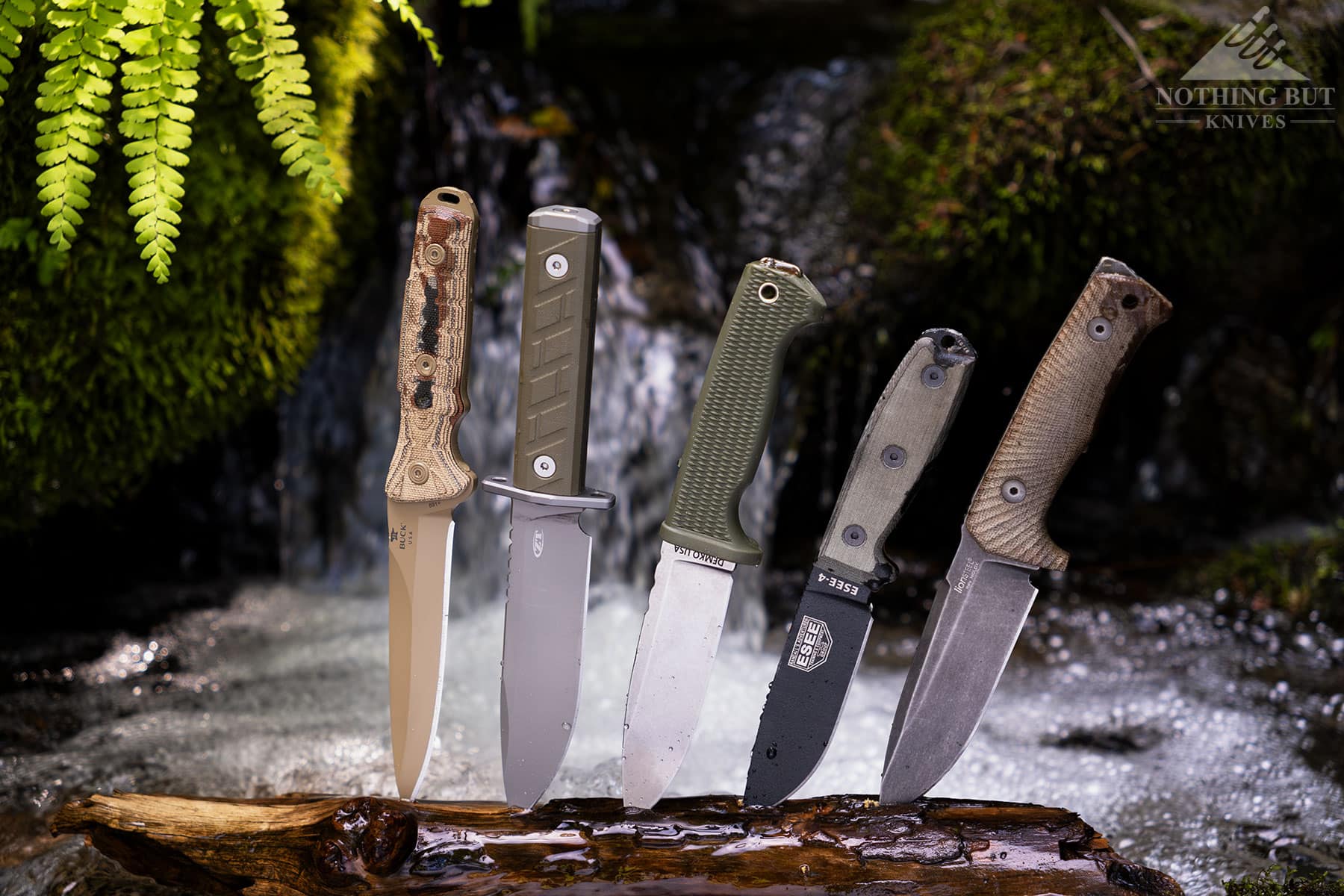
These aren’t exactly in a particular order, but we did try to arrange knives around our “best” for getting squirrely in the woods, so that knives with similar specializations were close to each other. The lines blur a lot, though, so that pattern doesn’t always hold up.
If you need a knife specifically for MOLLE or horizontal carry, there’s a lot of overlap here with our picks for the best horizontal fixed blades.
And if you don’t so much care for the bushcraft aspect of survival, you can check out our picks for the best tactical knives from our favorite brands.
Best Military Survival Knife – Ka Bar John Ek Commando Short Clip Point
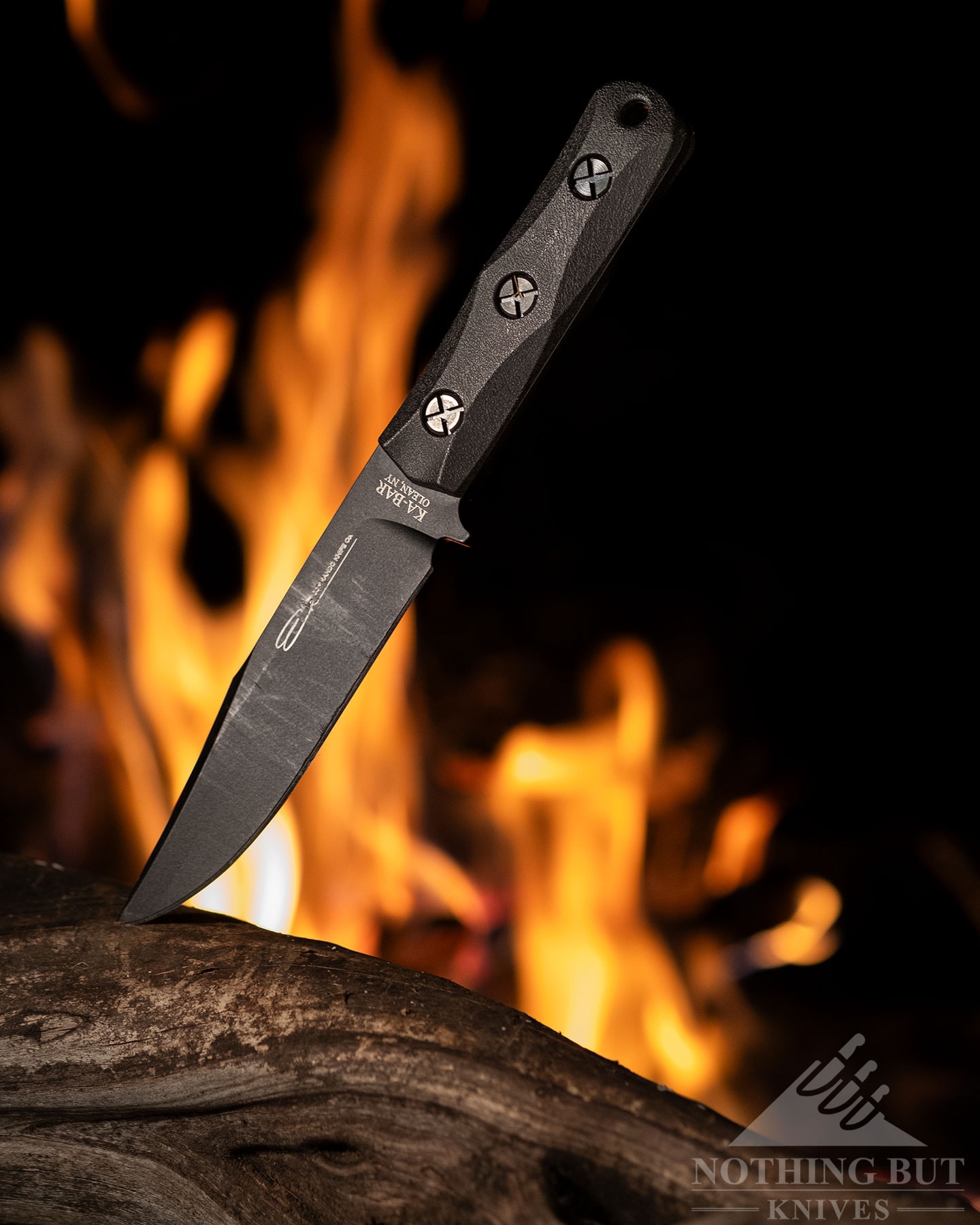
| Overall Length: | 9.25” |
| Blade Length: | 5.125” |
| Blade Steel: | 1095 Cro-Van |
| Blade Style: | Clip point |
| Blade Grind: | Flat |
| Handle Material: | Polymer |
| Sheath: | Ultramid |
| Made in: | USA |
This might be the most campground-friendly version of a John Ek line. The fighting-knife centric genre of battlefield knives has seen a lot of war and change over the years, but this latest iteration by Ka Bar made it more compact with an overall shape and design that emphasizes utility over combat. It carries well on the belt, and it’s so well balanced that it feels a lot lighter than it actually is.
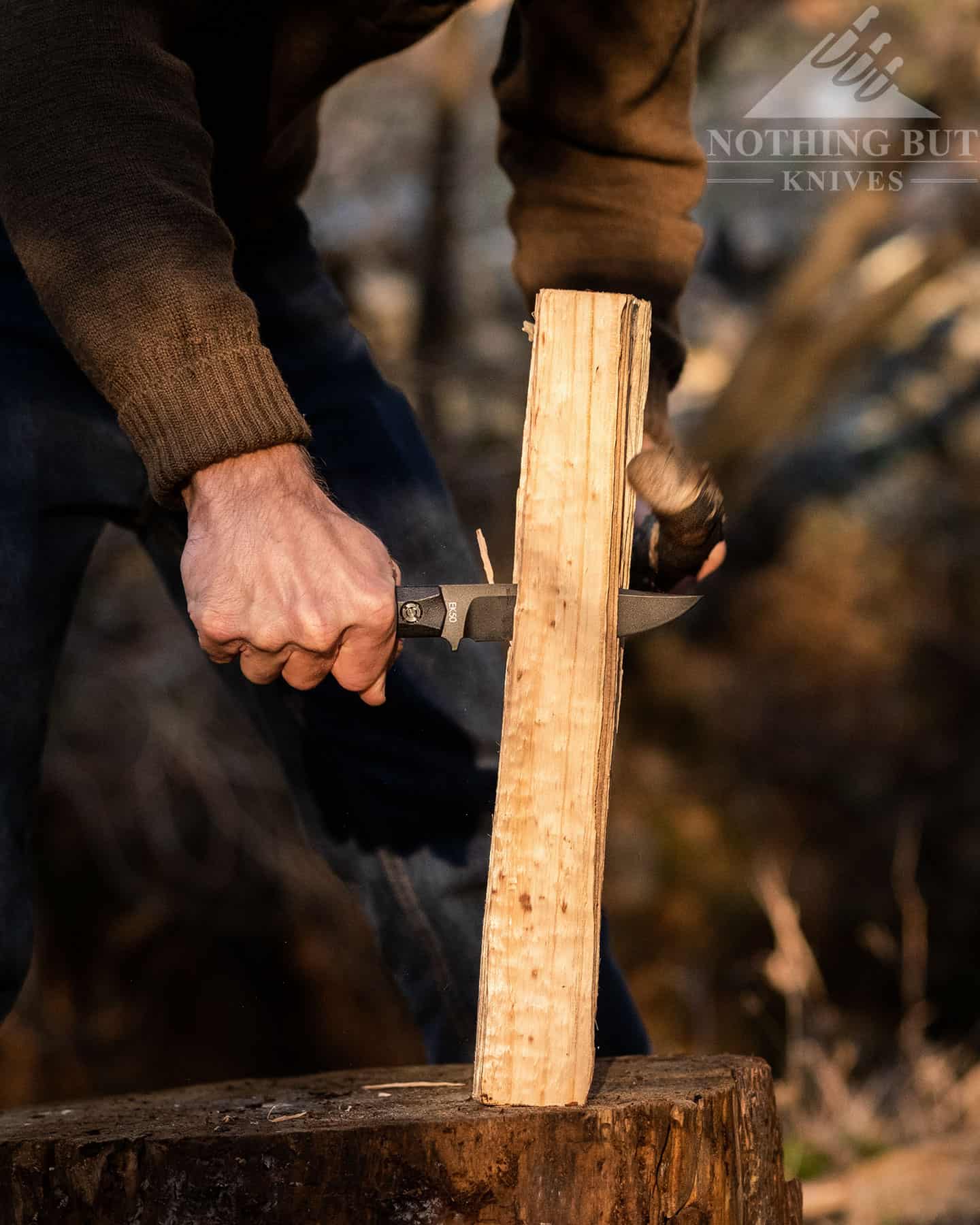
It still has the handle scallops typical of an Ek knife, which go a long way in providing a solid grip on otherwise smooth and economically-sized scales. It’s not the most comfortable knife, but it stays in the hand, indexes beautifully, handles all manner of wood processing tasks like a champ, and can take an enormous amount of abuse.
For a little more detail and historical context, check out our review of the Ek Commando Short.
Off Grid Backcountry V2
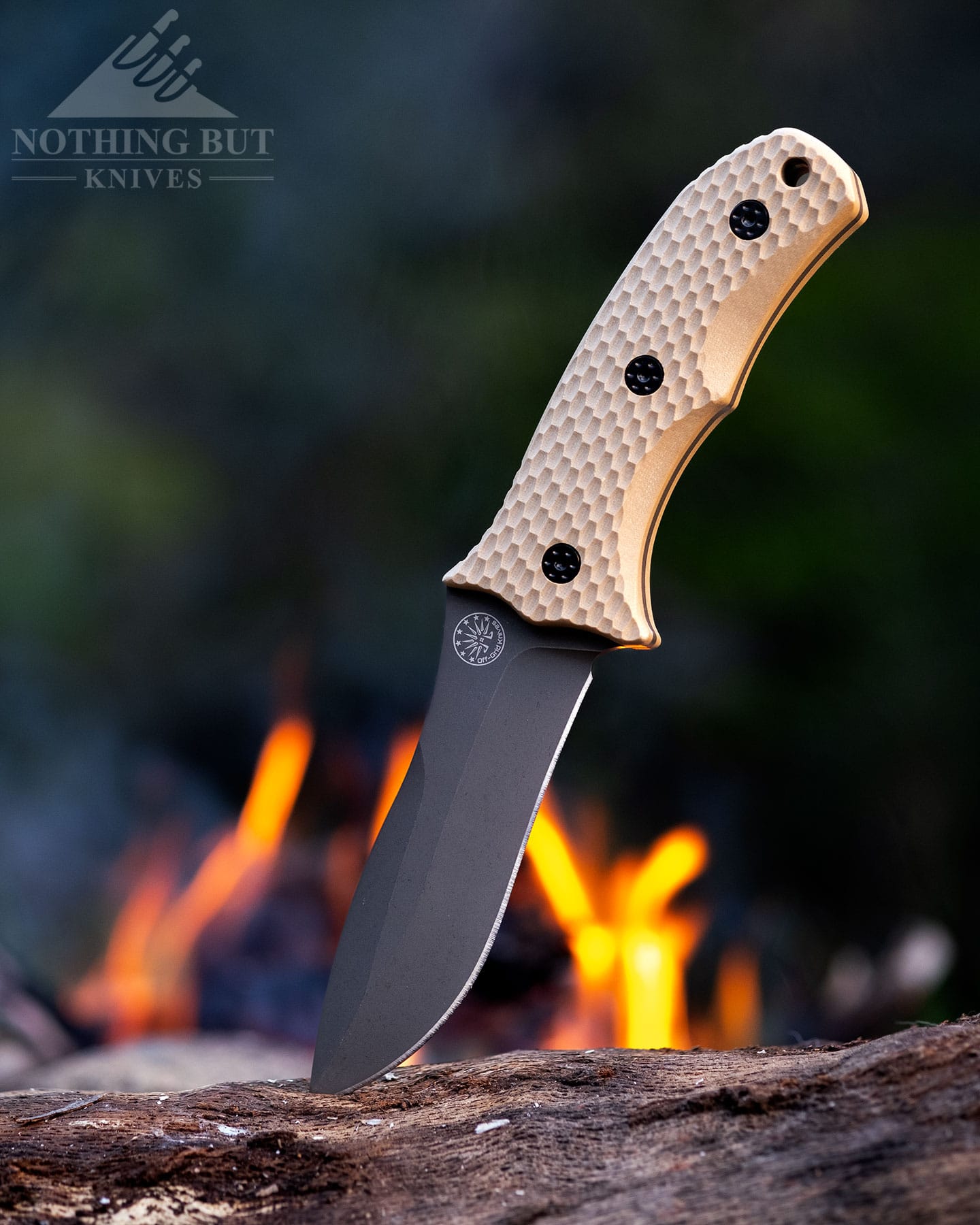
| Overall Length: | 9.25” |
| Blade Length: | 4.5” |
| Blade Steel: | D2 |
| Blade Style: | Drop point |
| Blade Grind: | Flat |
| Handle Material: | G10 |
| Sheath: | Kydex |
| Made in: | Taiwan |
| Designer: | Cary Orefice |
We’ve taken to calling this a tactical-hunting hybrid. The grind and blade shape make it really nice for skinning larger game, but it has a certain level of grip security and high-impact blade-shape efficiency that puts it pretty comfortably in the tactical category. There’s some clever grind work that makes the tip look and function a bit like a spear point, and Off Grid has a way with edge geometry that always seems to get the most out of D2 steel.
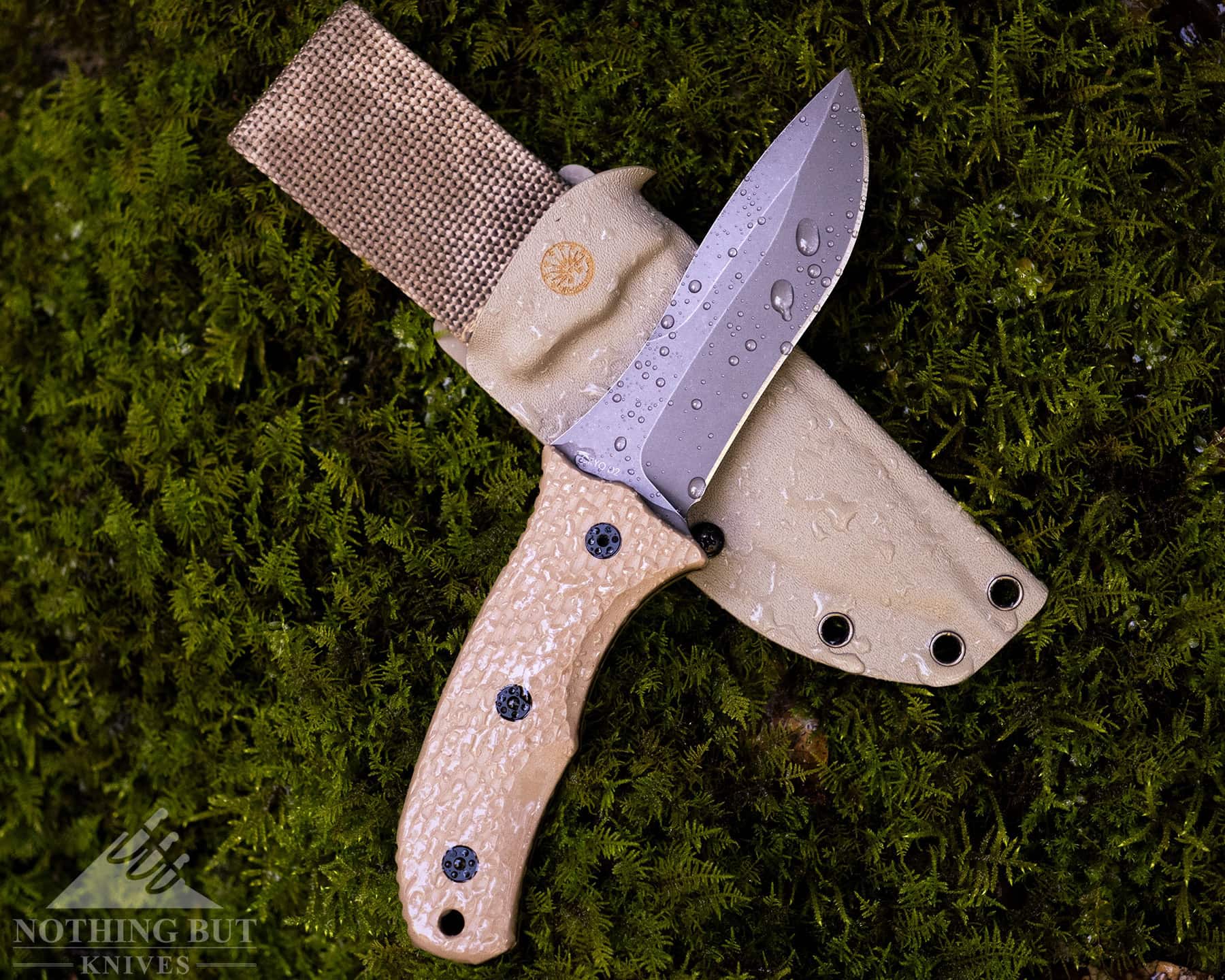
Off-Grid also does sheaths really well. The retention is spot on for this, and it has a well-shaped thumb ramp that provides plenty of leverage to pull the knife out easily. It comes with a nylon back that rides really well in the vertical position. Plus they make sure all their sheaths are Tek Lok-compatible.
You can read more about the Backcountry in our full review.
Cold Steel SRK
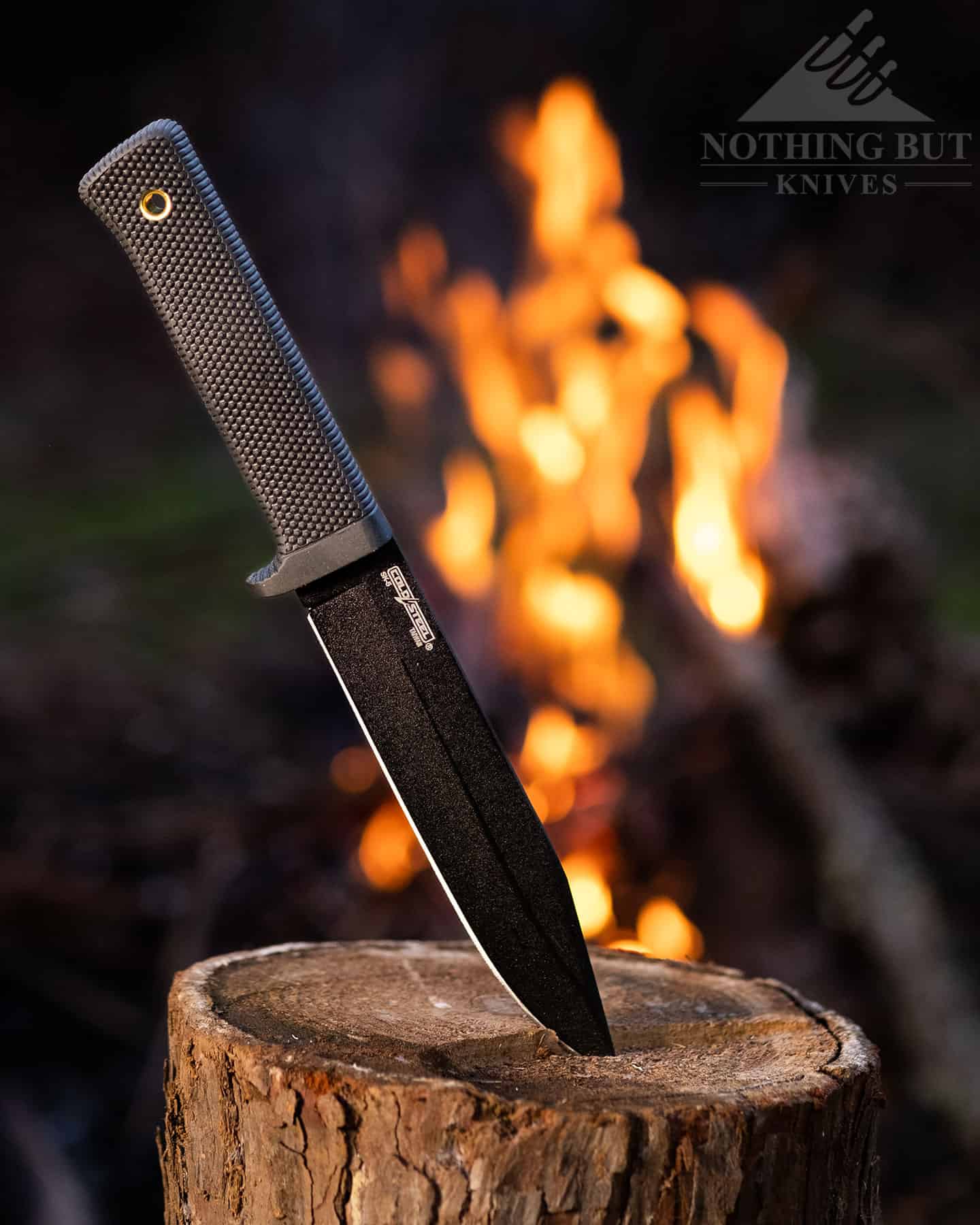
| Overall Length: | 10.75” |
| Blade Length: | 6.0” |
| Blade Steel: | SK-5 |
| Blade Style: | Clip point |
| Blade Grind: | Hollow |
| Handle Material: | Rubber |
| Sheath: | Polymer |
| Made in: | Taiwan |
It would be hard to overstate the amount of use and abuse this design has seen over the years. It has a brutally simple shape that makes it an effective tool in a lot of situations, and people of all kinds have packed it into all those situations.
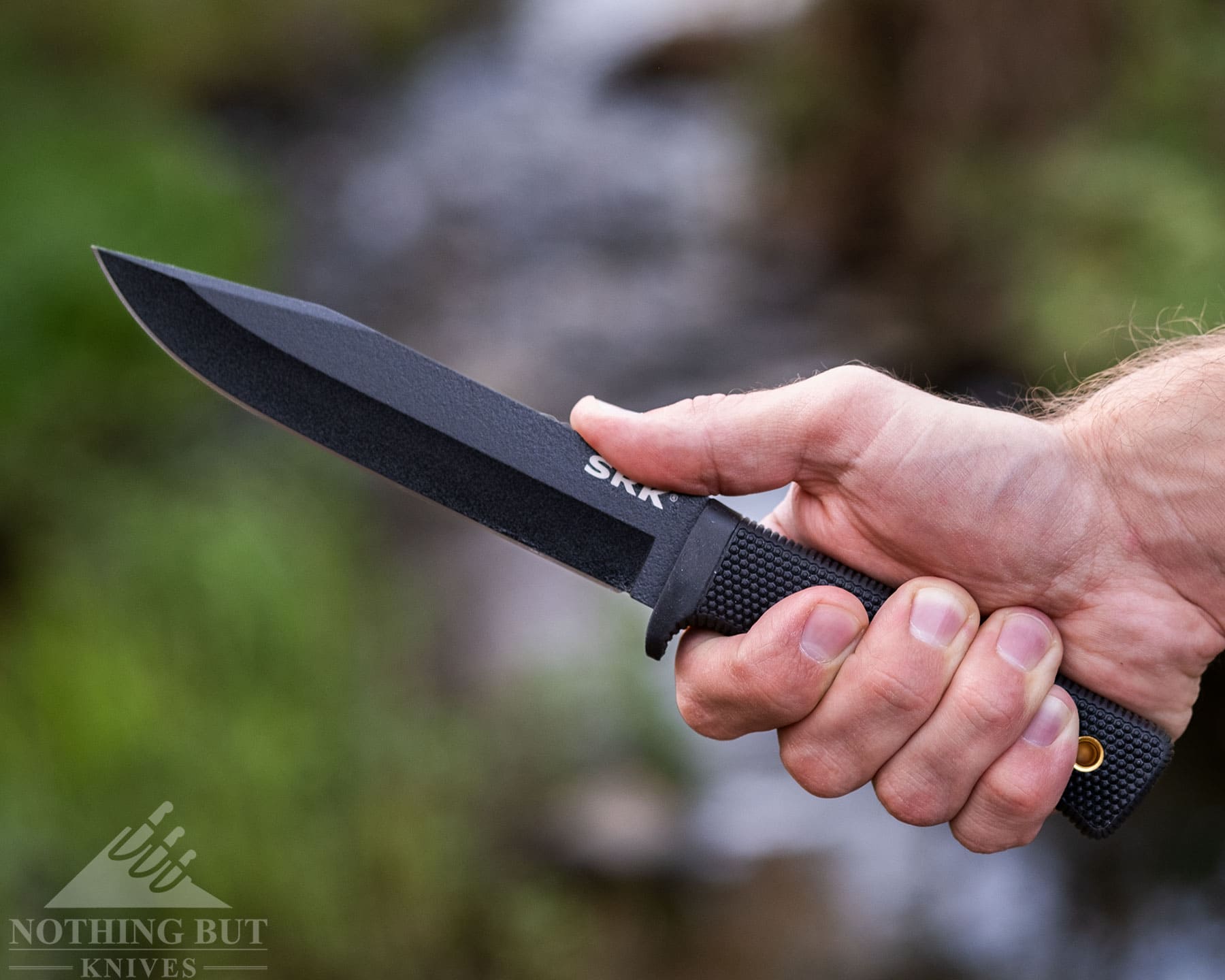
The rubber handle provides a firm grip and the neutral shape makes it equally comfortable in any grip you might care to use. The clip point gives the tip a little more piercing power, and the tough tool steel makes it one of the toughest knives on here.
The main thing you’ll need to worry about with the SRK is the rust-prone steel. The black finish on the blade will help a lot with that, but it’s not foolproof. If nothing else, you need to make sure the edge gets dried off regularly.
If you are looking for a knife that is similar to the SRK, but a bit smaller, check out the Falkniven F1.
Artisan Wreckhart
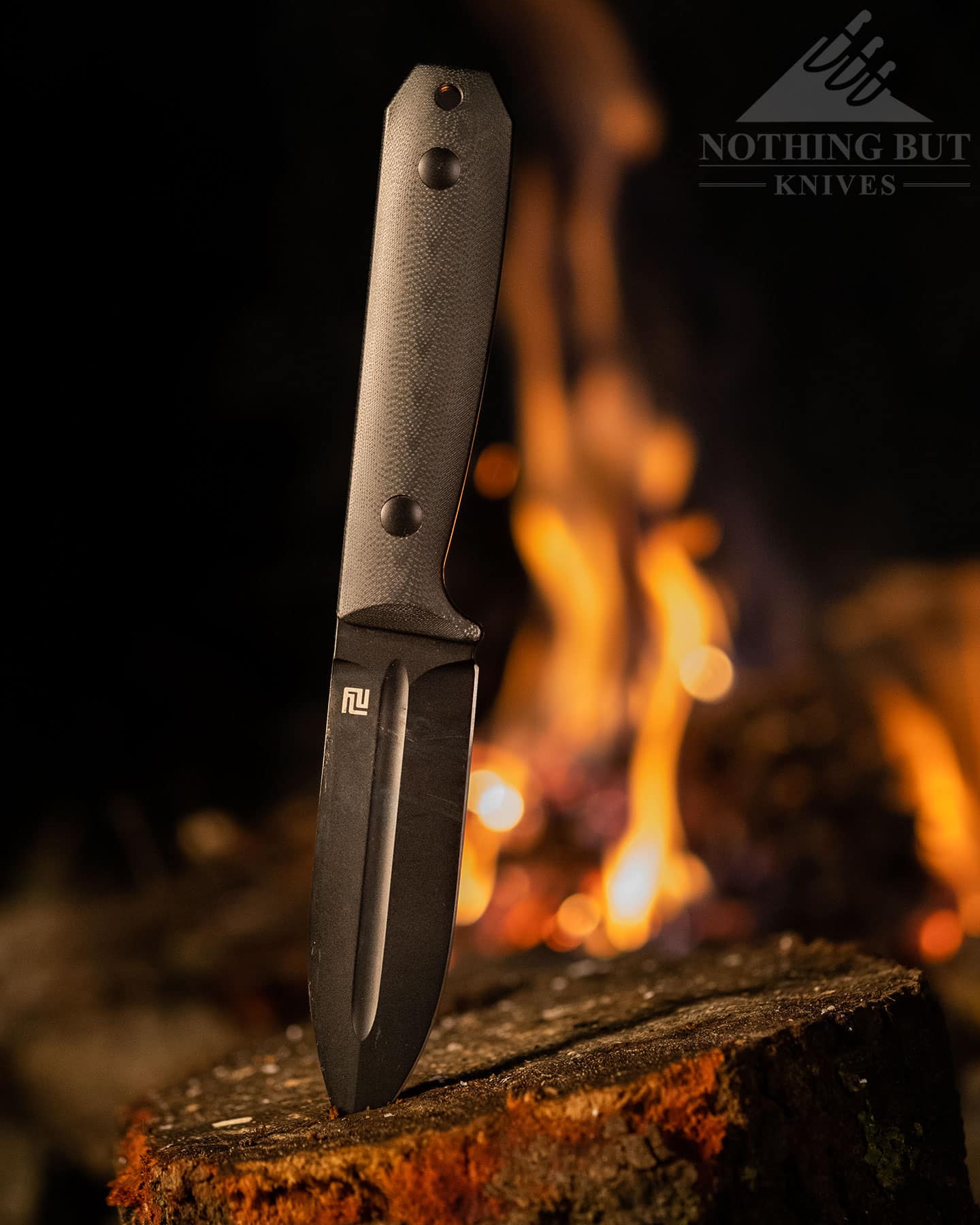
| Overall Length: | 9.25” |
| Blade Length: | 4.43” |
| Blade Steel: | AR-RPM9 |
| Blade Style: | Spear point |
| Blade Grind: | Flat |
| Handle Material: | G10 |
| Sheath: | Kydex |
| Made in: | China |
| Designer: | Joe Flowers |
This fusion of the Kephart knife and the Applegate-Fairbairn dagger is one of the better wood carvers we’ve used, oddly enough. The handle works incredibly well in a lot of different grips, but I especially like this for choking up on the blade to do detail work. For a big blade, it whittles like a champ.
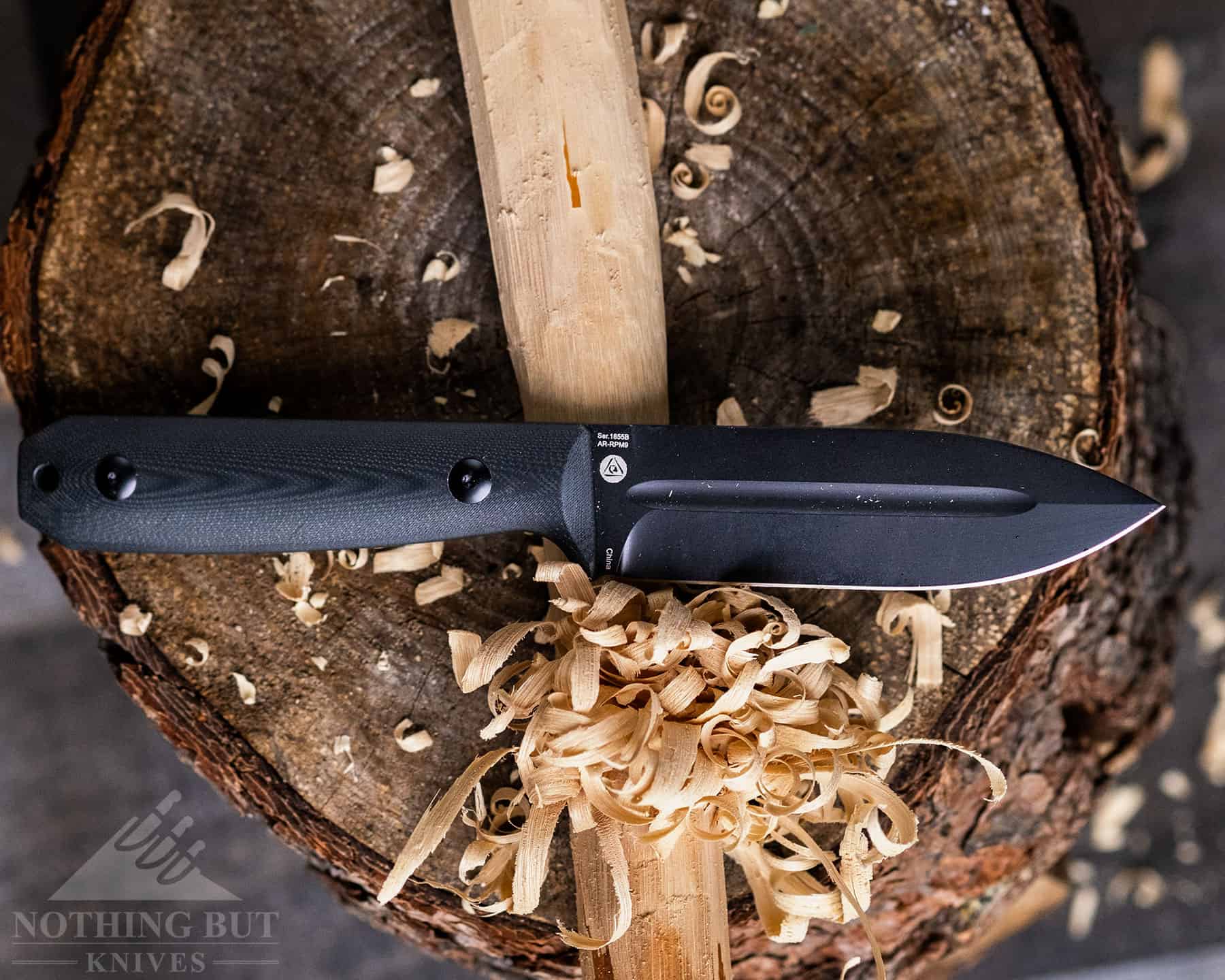
What puts it into the survival knife category is the blade shape and steel. AR-RPM9 is an amazingly tough powder steel that can take a thin, highly polished edge. You can get this thing into a vicious cutting shape, and it’s surprisingly easy to touch up in the field. The geometry also makes the blade sturdy against high impact, so even though it doesn’t chop or baton quite as well as other knives on this list, it can take the abuse, and overall it’s lighter and better balanced, and one of the few stainless steel options on here.
Check out our full review of the Wreckhart here.
Best Fire Starter – White River Firecraft Puukko
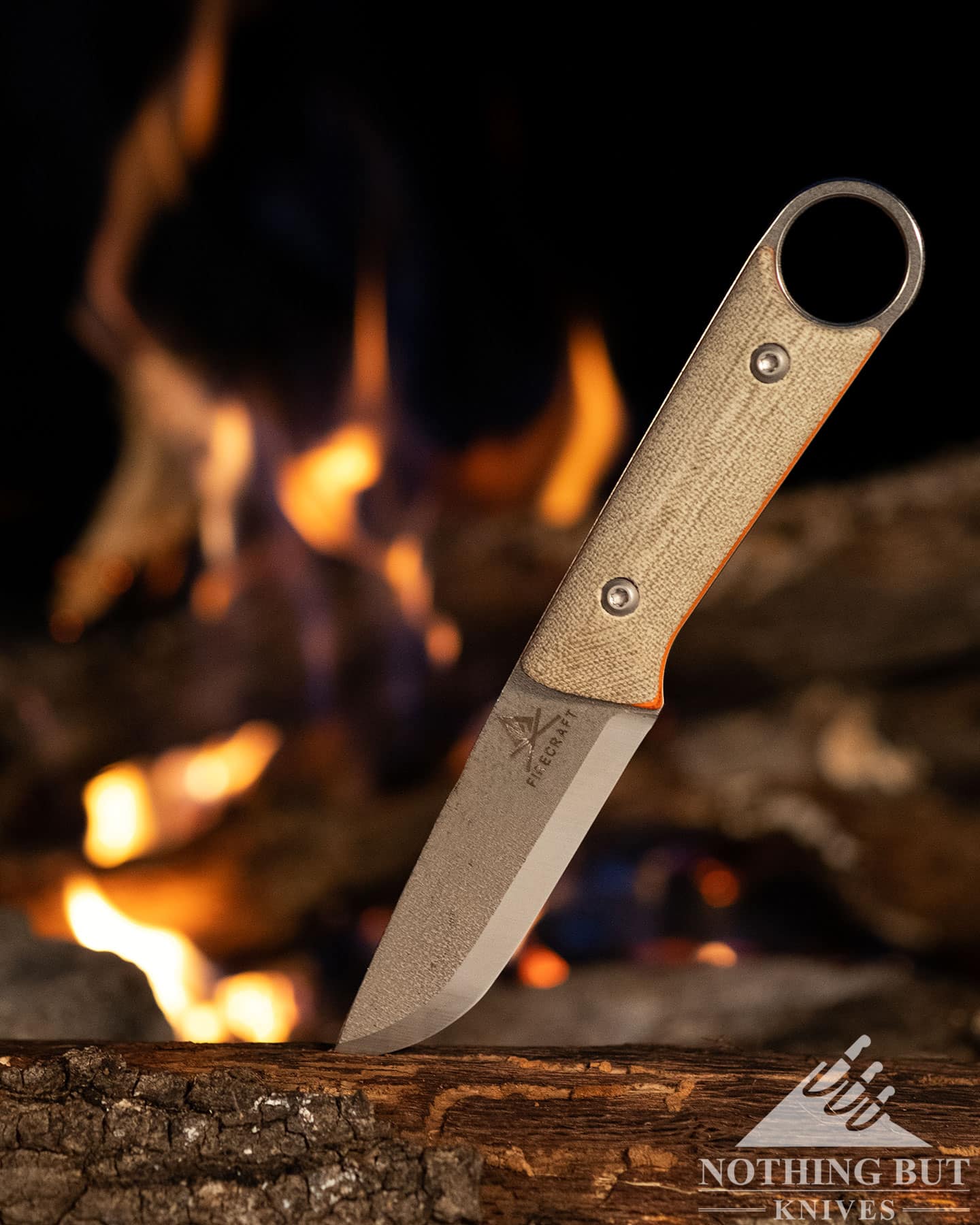
| Overall Length: | 8.0” |
| Blade Length: | 3.75” |
| Blade Steel: | S35VN |
| Blade Style: | Drop point |
| Blade Grind: | Scandi |
| Handle Material: | Micarta |
| Sheath: | Kydex |
| Made in: | USA |
| Designer: | Jason Tietz |
The Firecraft leans more toward the bushcraft element of survival than the tactical, but between the size, weight, and the ring at the pommel, the Firecraft is a good subtle-carry option with a solid grip that deploys out of the sheath fast.
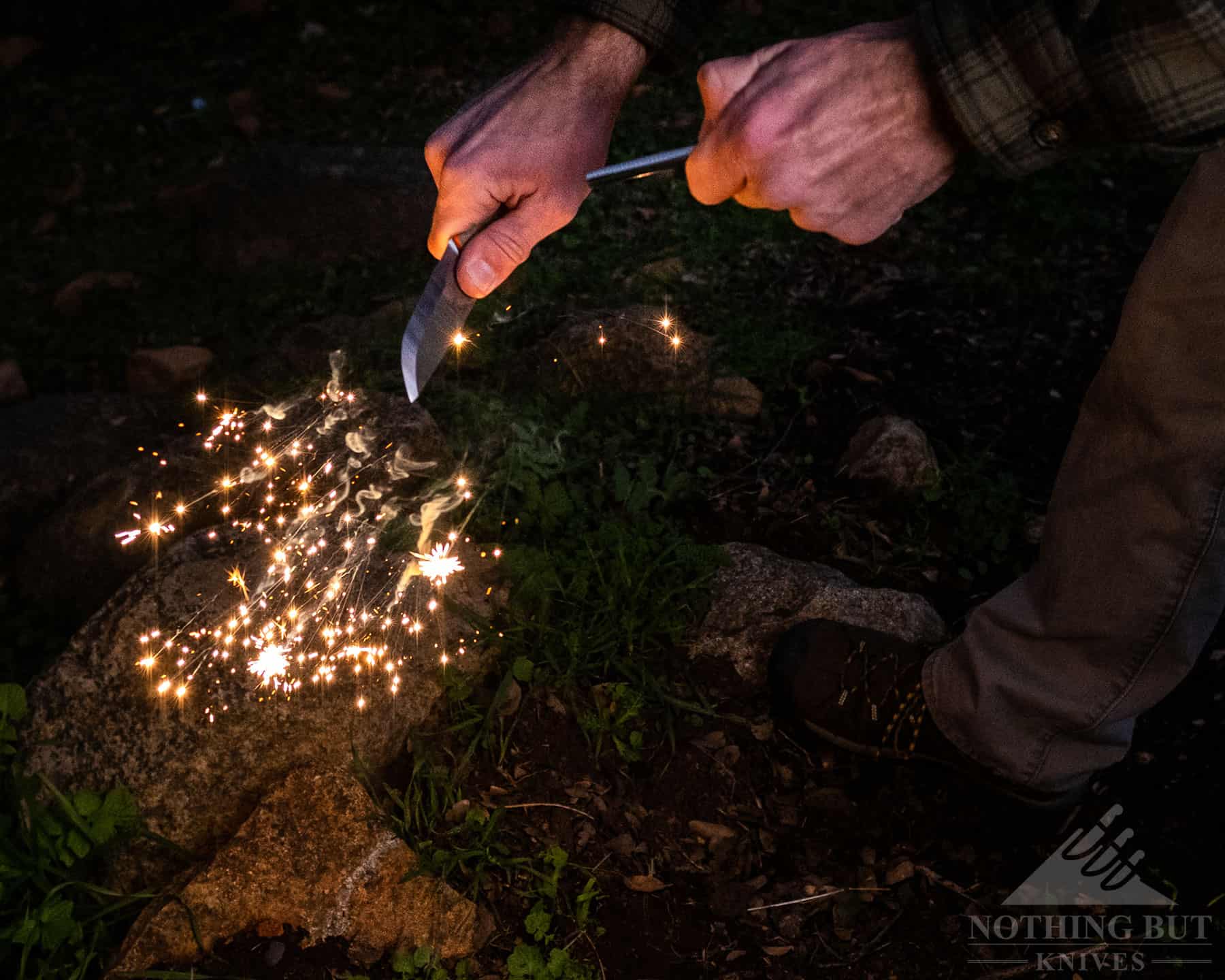
The way it’s been optimized for starting fires also gives it a sort of woodsy multitool characteristic. It works beautifully with a fire steel, and while we’ve never been big fans of using fire bows, the steel divot they put in the handle for it is one of those little features that often ends up offering a lot of utility for how little space it takes up.
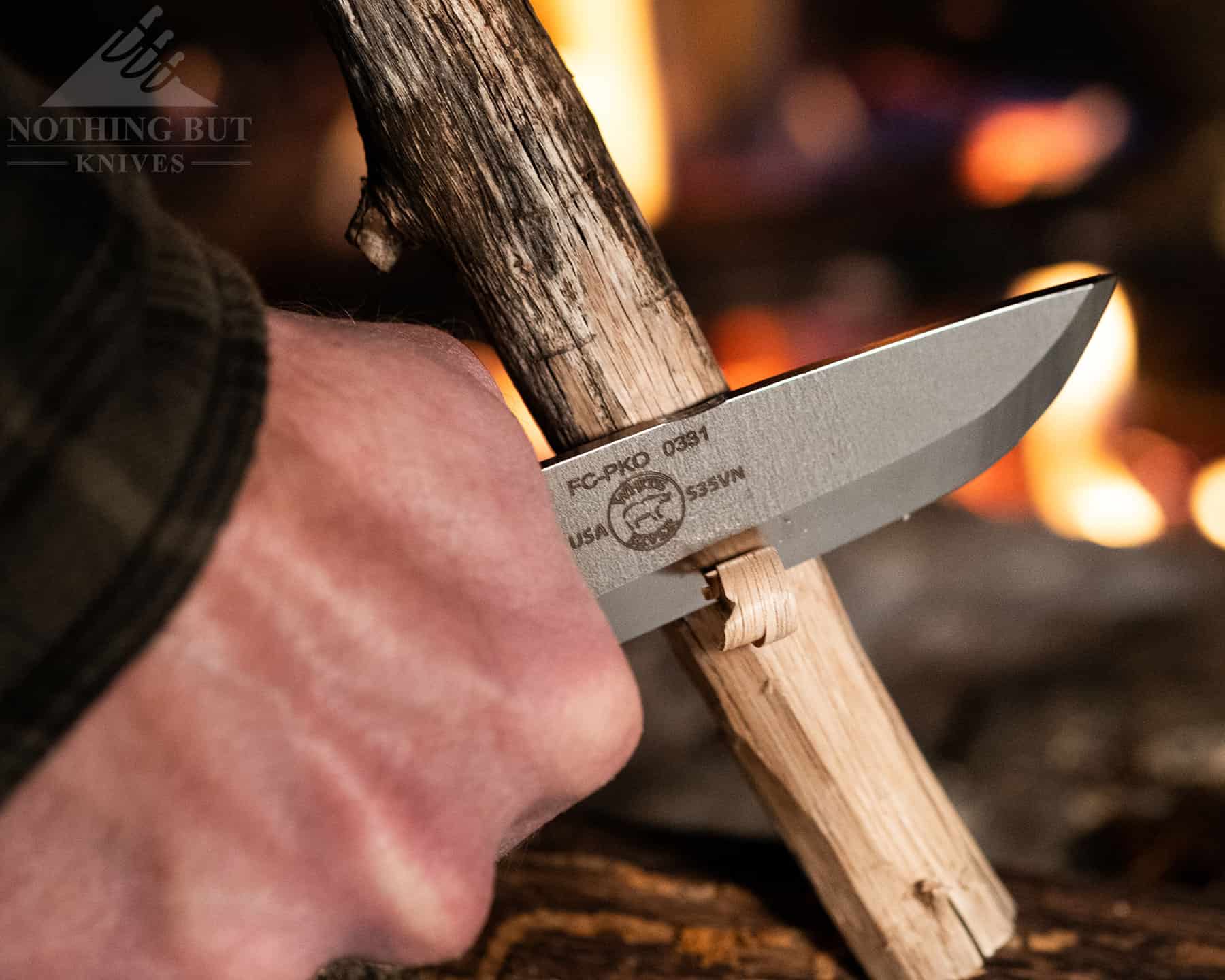
The Firstarter is also one of the better stainless steel options on the list. S35VN might be getting a little retro in terms of super steels, but it’s still a ringer for edge retention and corrosion resistance.
Check out our in-depth White River Knives Firecraft Puukko Review to learn more about this versatile fire starter.
Best Big Survival Knife – Ka Bar BK7
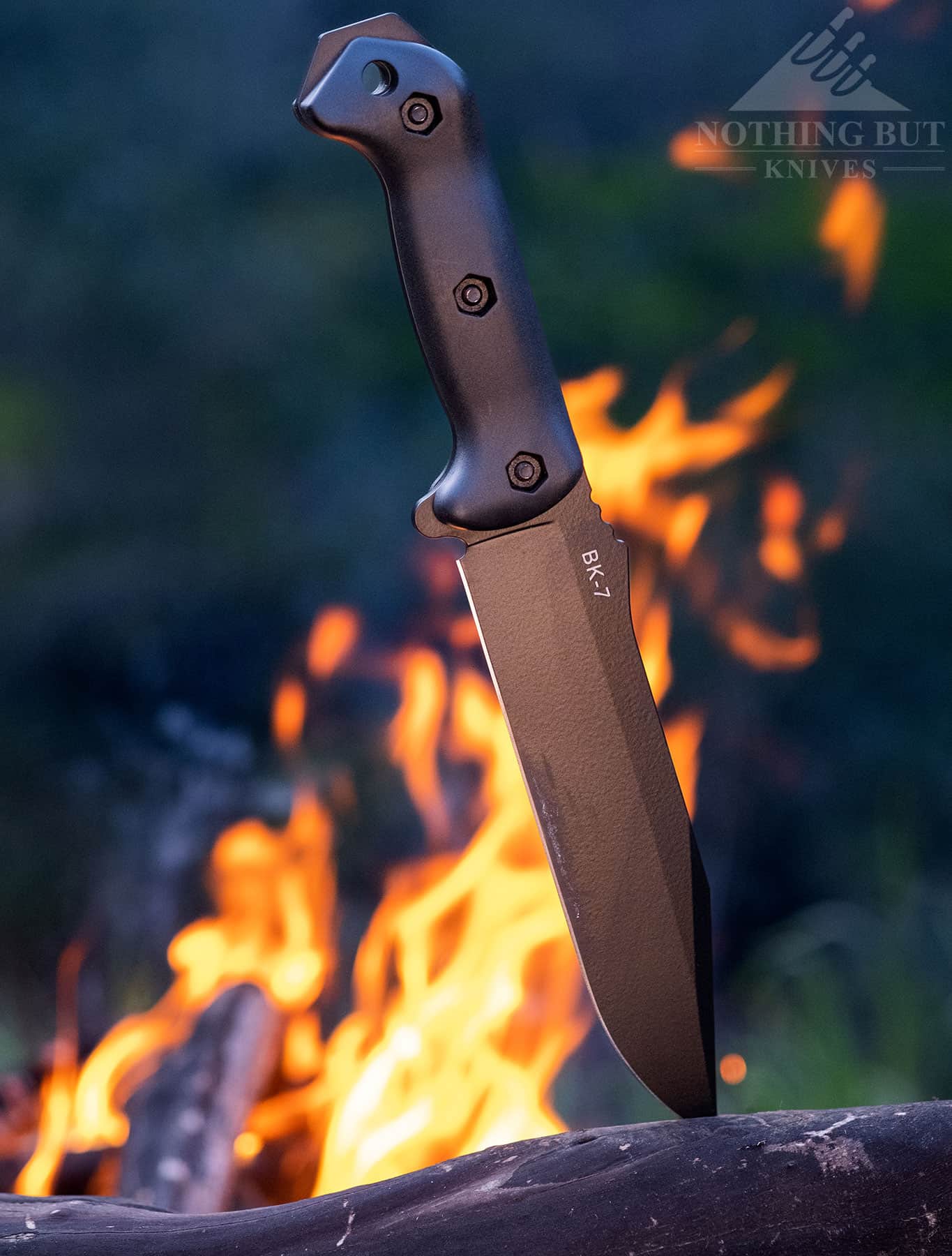
| Overall Length: | 12.75” |
| Blade Length: | 7.0 |
| Blade Steel: | 1095 |
| Blade Style: | Clip point |
| Blade Grind: | Flat |
| Handle Material: | Zytel |
| Sheath: | Nylon |
| Made in: | USA |
| Designer: | Ethan Becker |
The BK7 sits somewhere in between a machete and a bowie knife. It has a strong clip point, and it’s even weighted like a lot of big bowies. Plus the jimping along that hump on the spine gives you a lot more control for a certain amount of carving work.
It still feels like a big damn knife, but that mix of elements around the top of the handle does a lot to make the BK7 feel a lot more manageable for tasks other than swinging and stabbing.
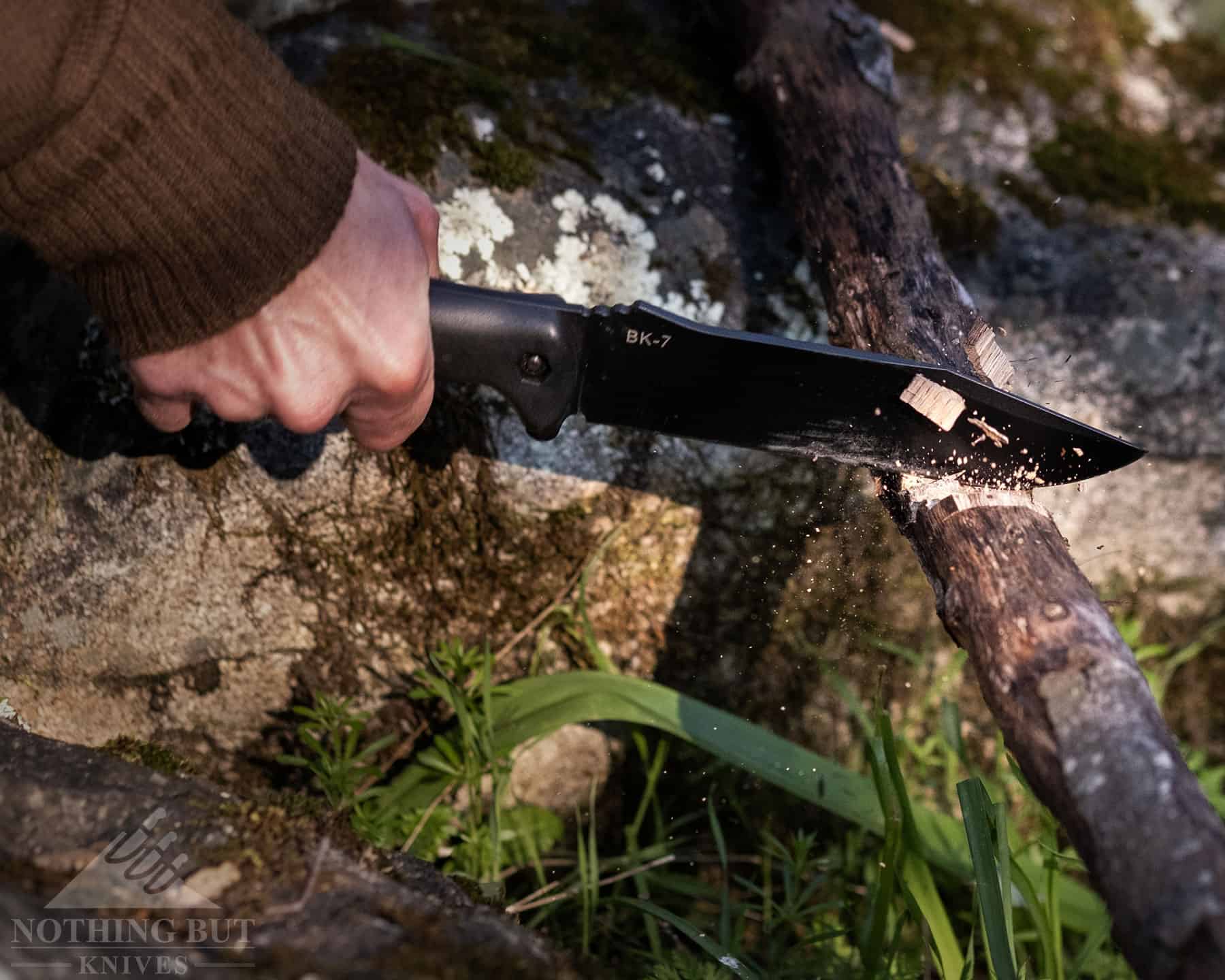
When it comes to swinging, though, this is a beast of a knife. The handle shape provides grip security that’s great for getting and controlling a lot of momentum in your swing. The factory edge isn’t perfectly optimized for chopping, but this is the kind of design that makes it easy to find a way around the edge getting munged up.
You’ll see one or two other Ethan Becker designs on this list, but the truth is that Ka-Bar Becker knives could fill this whole list out. Pick up any of his knives, and you’ll be holding a good tool for just about any survival situation.
- If you want a smaller version of this, check out the BK10 Crewman.
- If you want something that’s a little more like a machete, check out the BK20.
- If you want something smaller and more general purpose, check out the BK22 Companion.
- If you want something that folds, check out the BK40 Becker Folder.
We could go on, but you get the point.
Gideon’s Tactical has a great video review of the BK7 if you want a bit more in-depth analysis on this beast.
Demko FreeReign
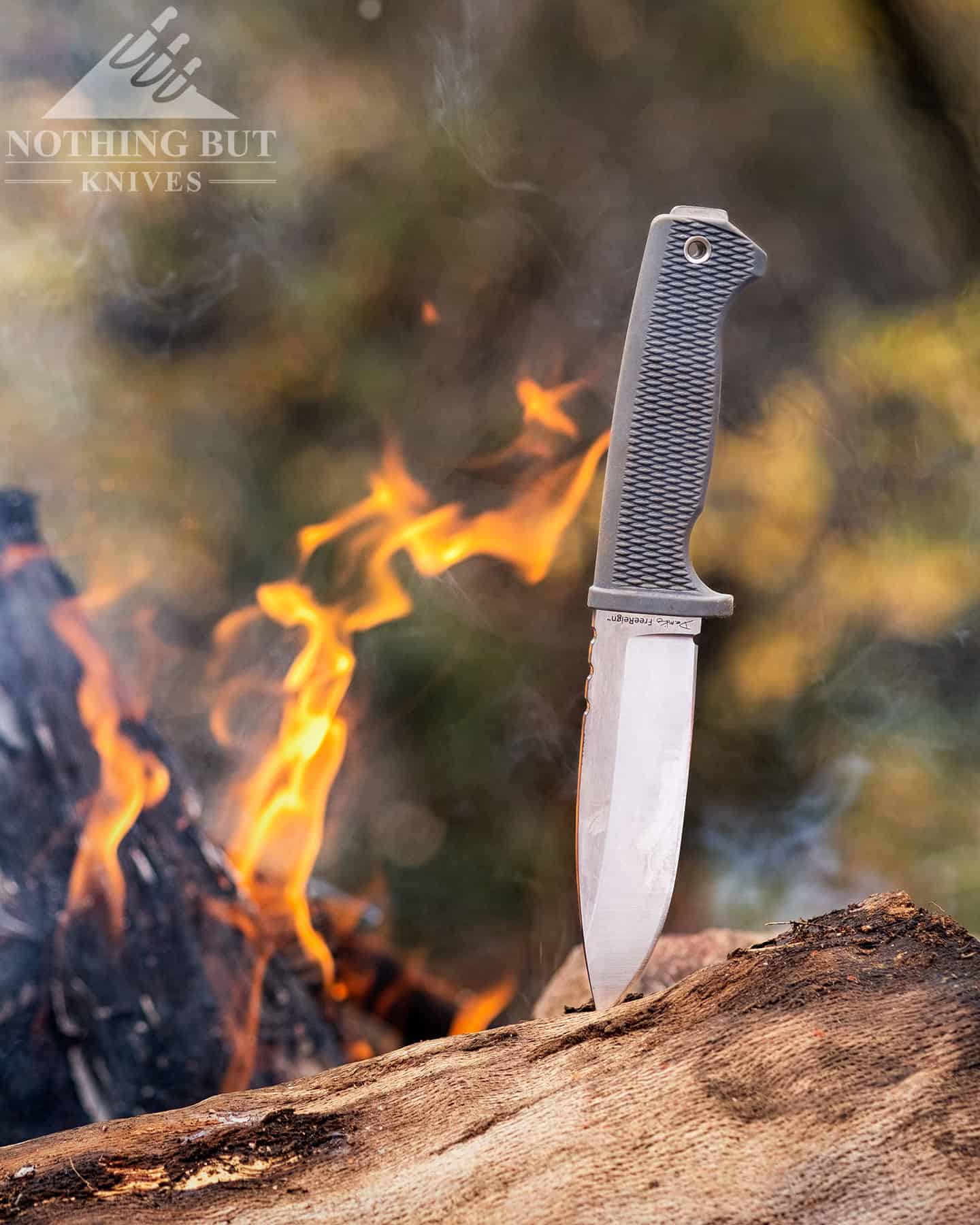
| Overall Length: | 9.875” |
| Blade Length: | 5.0” |
| Blade Steel: | AUS-10A |
| Blade Style: | Drop point |
| Blade Grind: | Flat |
| Handle Material: | Injection-molded rubber |
| Sheath: | Nylon / polymer |
| Made in: | Taiwan |
| Designer: | Andrew Demko |
The Free Reign feels a lot like the Cold Steel SRK in terms of grip and texture, but the size fills the hand a lot better. It’s just a beefier knife all around, which is surprising, since the design template was Demko’s AD15 folder.
There are two stand-out features on the FreeReign (besides the comfort and the razor factory edge): the shape of the handle locks your hand into place, and the sheath was designed to be easy to clean and avoid dulling the knife on sheathing and drawing.
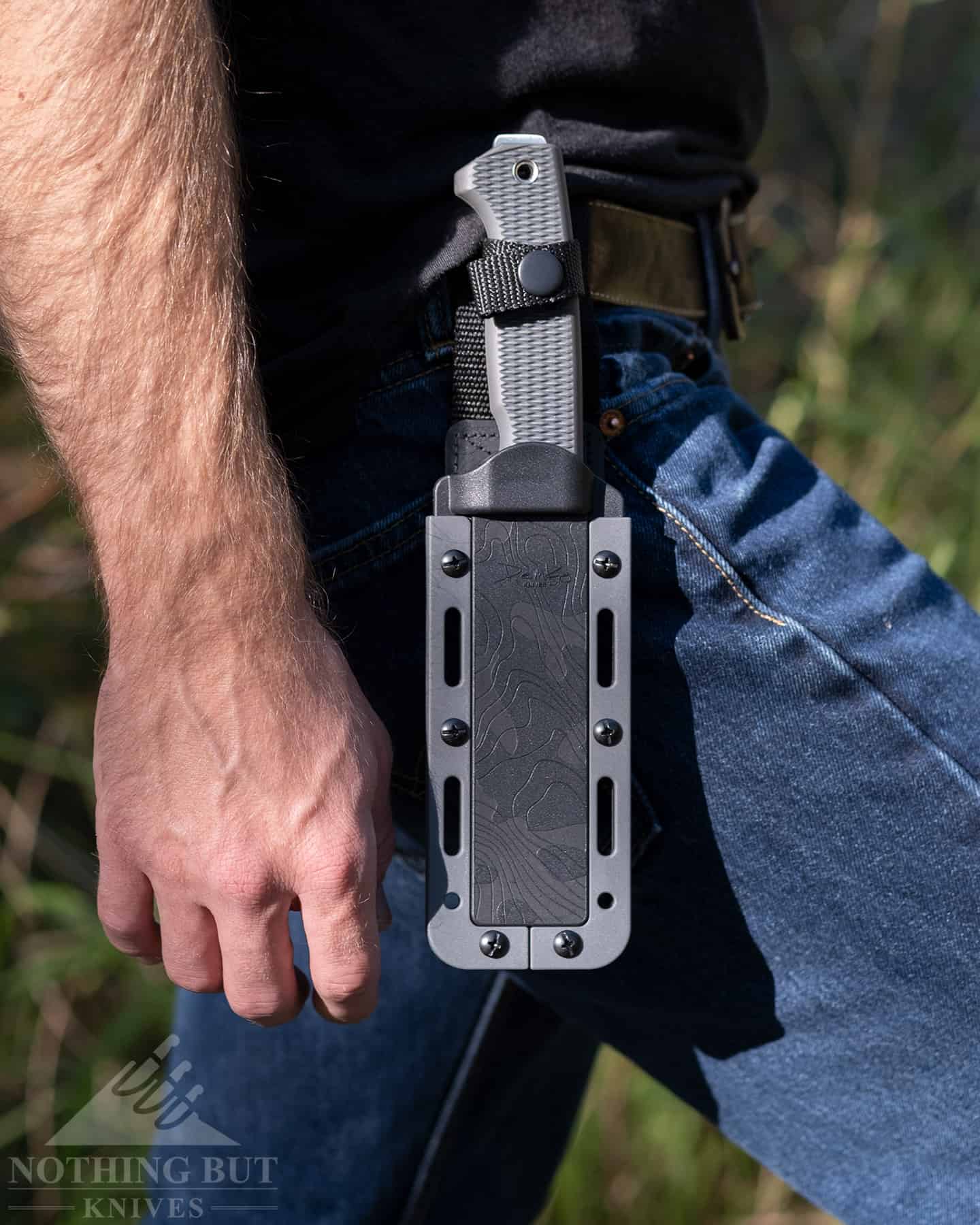
Honestly, I’m not sure the handle needs the finger guard at the top to protect the hand and grip (I still like having it there, though). The finger grooves on it are contoured just right to optimize your grip along with the rubber texture of the material. You could swing this thing with one finger around the pommel and still have a firm grip on the knife.
The sheath is the more interesting innovation, though. It has a nylon core with a harder polymer border to keep the shape, with Tek Lok-compatible holes. We found the stock belt loop to be pretty decent, but you can play around with all kinds of MOLLE configurations.
If you want a little more detail about what all this looks like, you can check out our full review of the FreeReign.
Most Comfortable Pick – Ka Bar BK18
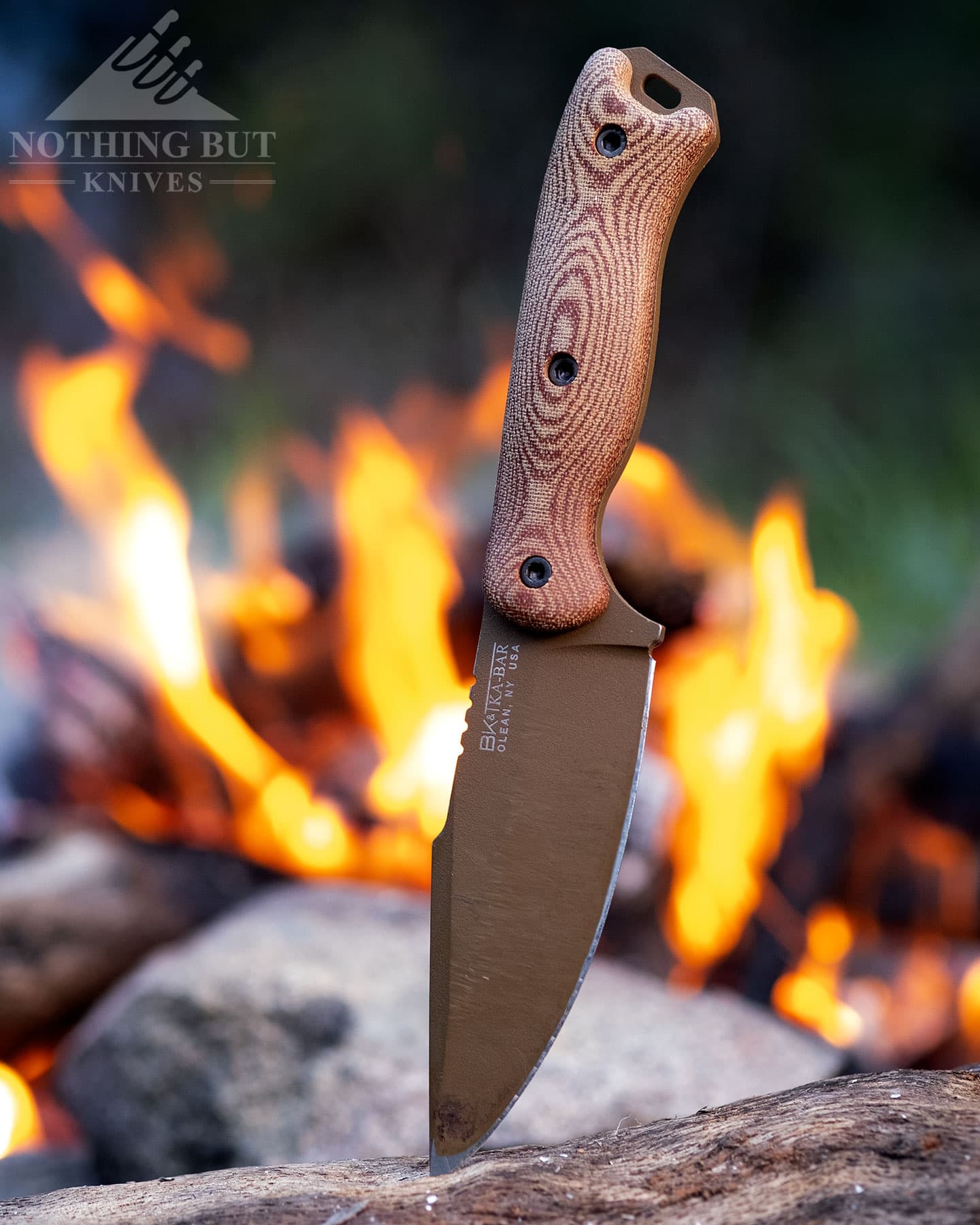
| Overall Length: | 9.375” |
| Blade Length: | 4.5” |
| Blade Steel: | 1095 Cro-Van |
| Blade Style: | Harpoon |
| Blade Grind: | Flat |
| Handle Material: | Zytel |
| Sheath: | Celcon polymer |
| Made in: | USA |
| Designer: | Ethan Becker |
We mentioned before that pretty much every Ethan Becker design fits in this list, but we wanted to point out the BK18 from the line up because the blade shape makes it a little more unique.
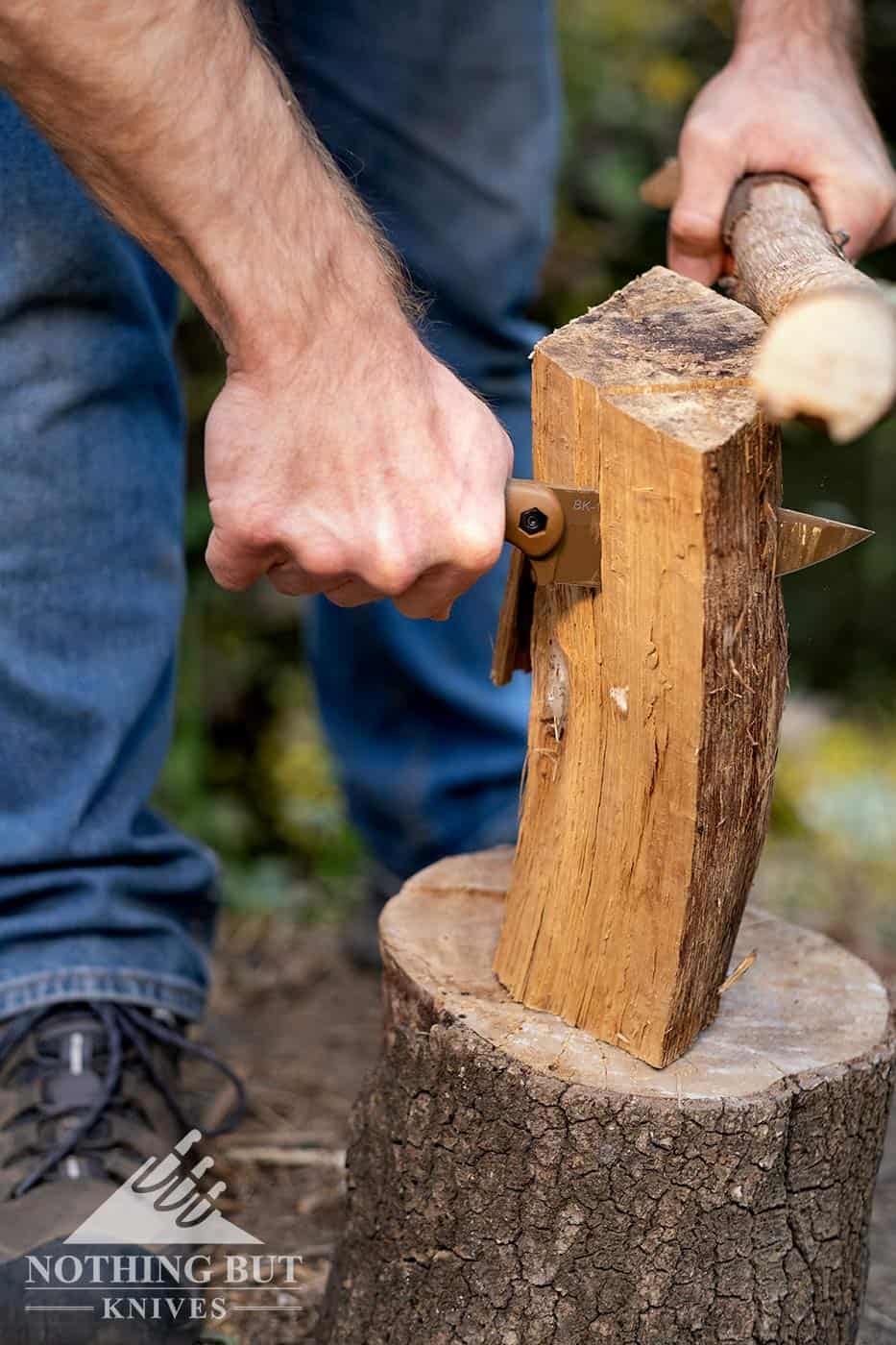
Ergonomically, it gives the thumb a little more purchase further up the blade, which is nice for bushcraft-y things like carving notches and feather sticks. But this was very much designed with a tactical mindset. They’ve used the extra steel from the harpoon shape to reinforce the tip, and the blade has a little more height than most other Becker knives so there’s a little more belly. All of which seems to add up to the BK18 being a bit slicier than your average Ka Bar.
Check out our full review of the Ka Bar BK18 Harpoon here.
Best Premium Survival Knife – Reiff F4
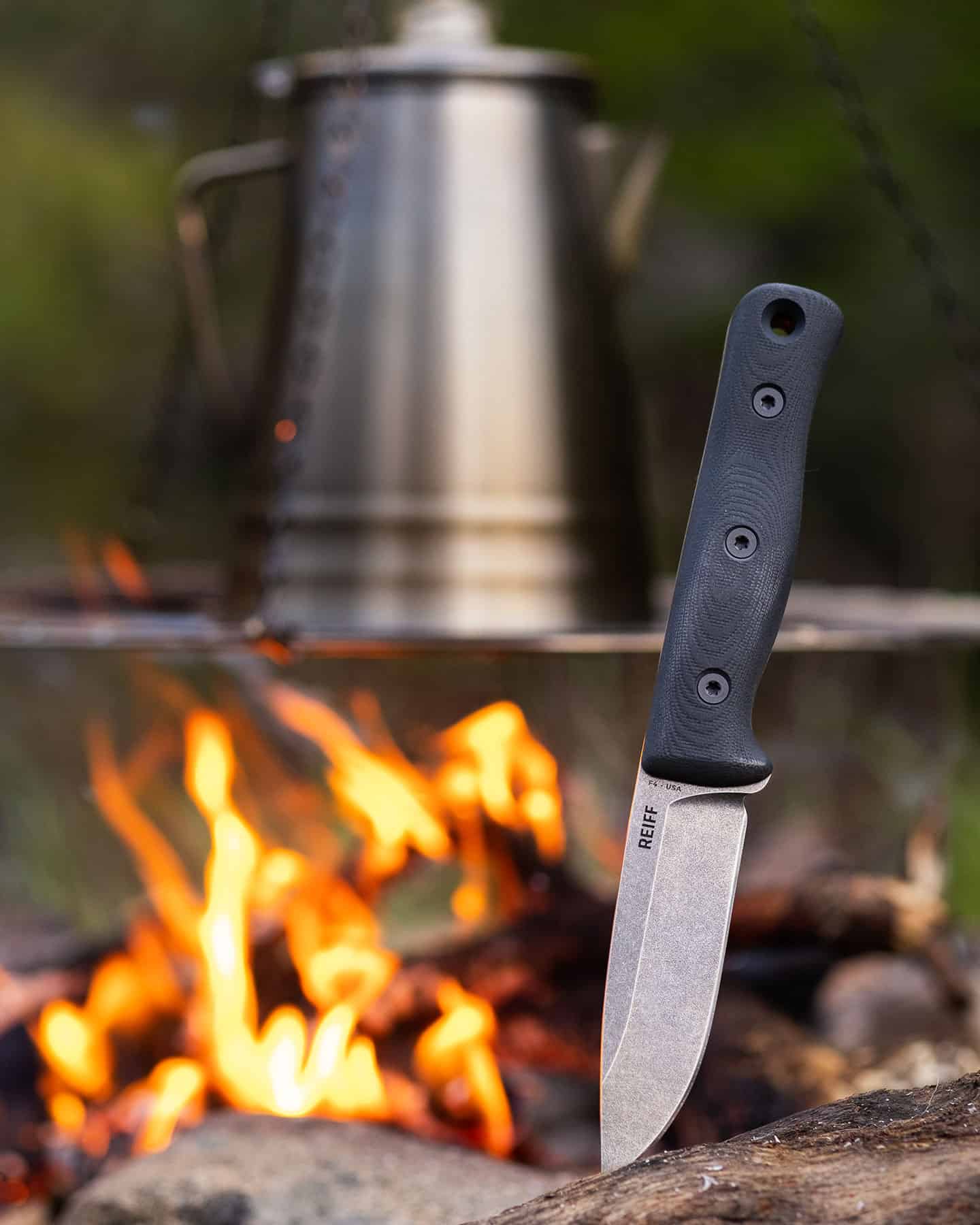
| Overall Length: | 9.0” |
| Blade Length: | 4.0” |
| Blade Steel: | CPM 3V |
| Blade Style: | Drop point |
| Blade Grind: | Flat |
| Handle Material: | G10 |
| Sheath: | Kydex or leather |
| Made in: | USA |
Reiff handles don’t feel like any other knife we’ve carried. They have something like the shape of some Ka Bar Becker knives, but Reiff grinds the top of the handle so it flares out. It’s not the kind of thing you notice until you hold it, but that shaping gives the F4 an incredibly secure grip so even the smooth G10 scales never seem to slip from the hand.
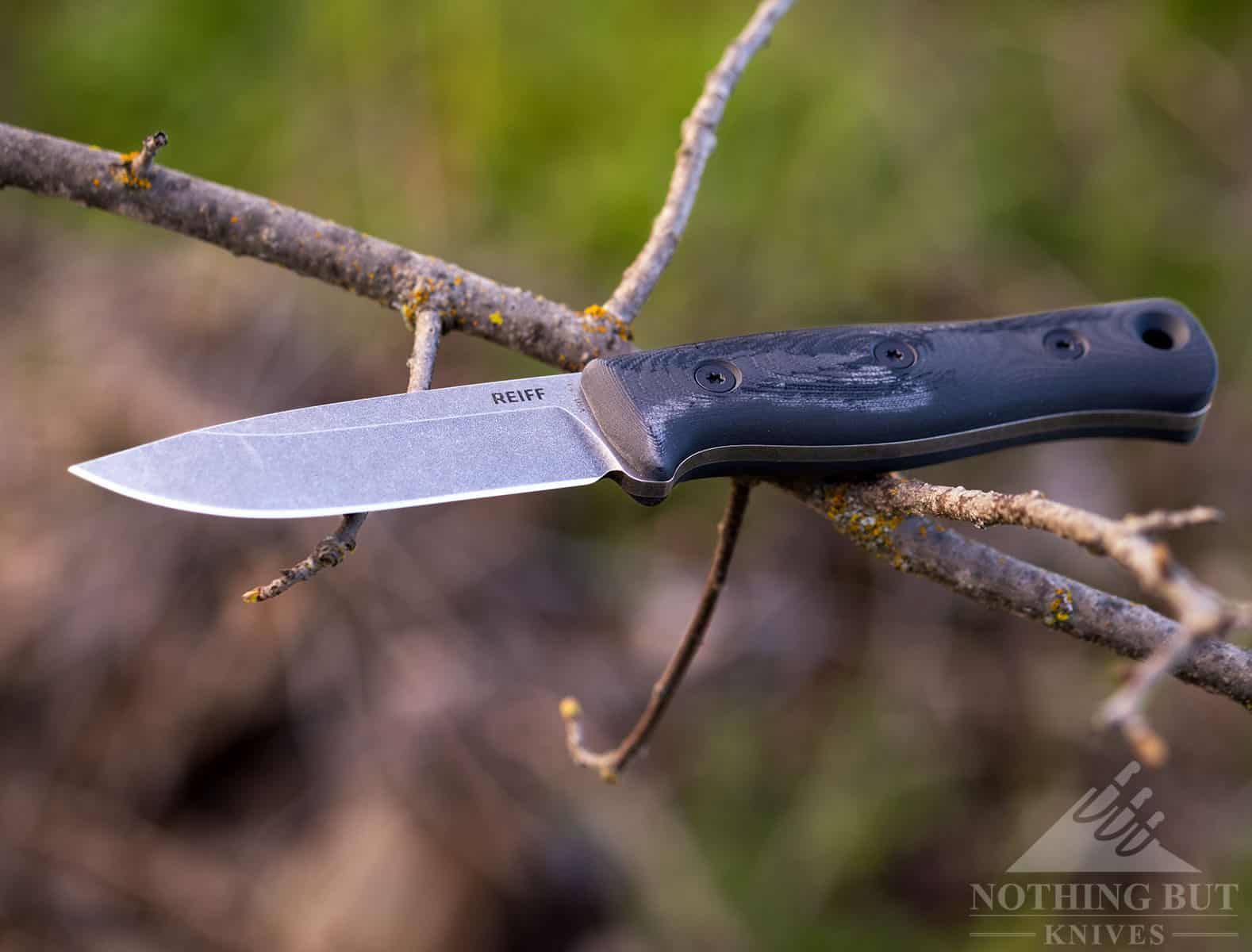
If the F4 had a scandi grind we would probably hold it as a pure bushcraft pick, but the flat grind, firm-grip ergos, and tough powder steel leave a lot of room for creative utility if you find yourself in an emergency situation. They also usually send this knife with a Kydex sheath and a leather sheath. That Kydex option rides really light on the belt, and the belt-carry system can freely rotate so there are a lot of ways to carry the knife, to say nothing about how easily the F4 deploys from the sheath.
You can learn more about this great American survival knife by checking out our Reiff F4 Review.
Boker Bronco
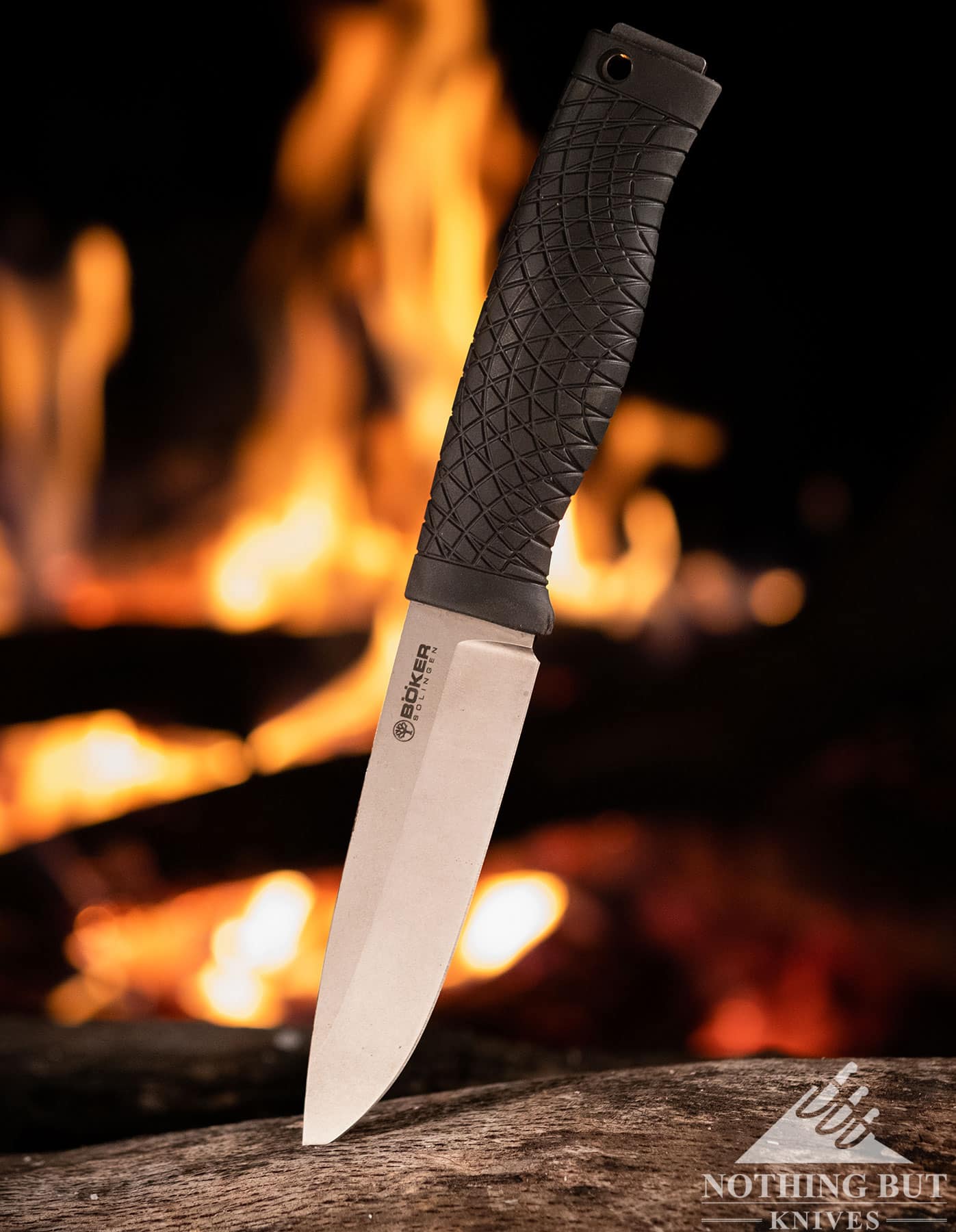
| Overall Length: | 9.13” |
| Blade Length: | 4.45” |
| Blade Steel: | CPM 3V |
| Blade Style: | Drop point |
| Blade Grind: | Flat |
| Handle Material: | TPE |
| Sheath: | Leather |
| Made in: | Germany |
This is a Falkniven F1 alternative. I won’t beat around the bush on that. I’ll just point out that the Bronco is sporting CPM 3V steel, which is usually quite a bit tougher than the VG10 on a standard F1, and possessing some of the heightened edge-taking-and-holding abilities typical of powder steels.
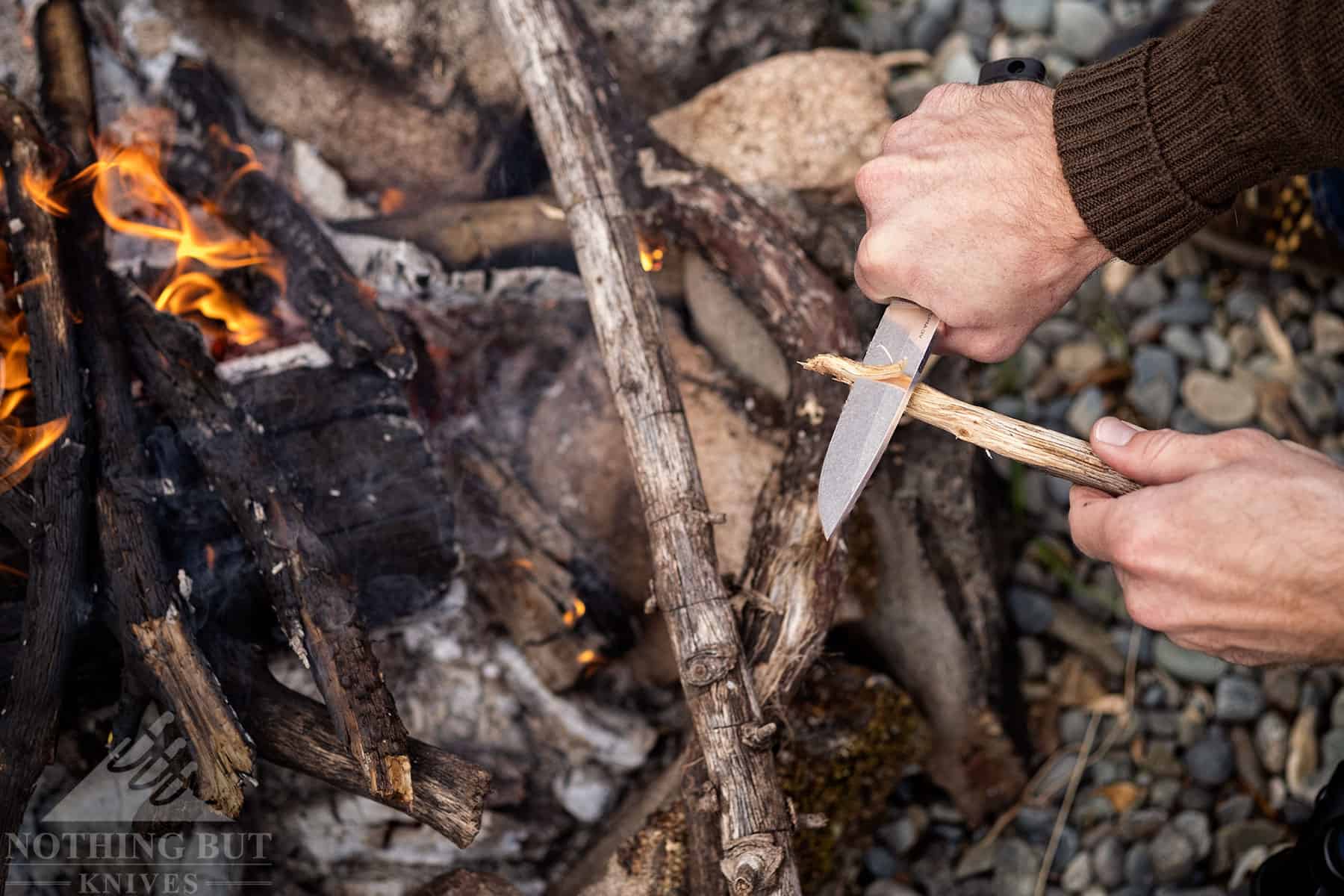
The downside is that 3V isn’t stainless and Boker didn’t bother putting any kind of coating on the blade, so you’ll have to be a little more vigilant about keeping this dry. But it has a much more aggressive edge thanks to the flat grind, and it ships with a Light My Fire ferro rod, which – if you’ve never used one – will change your whole fire-starting life.
The sheath is a pretty simple leather configuration set up for right-hand vertical carry. Nothing too exciting here except that it looks good, rides well, and has a loop for a fire steel. This is an all around high performer for every outdoor task.
LionSteel T5
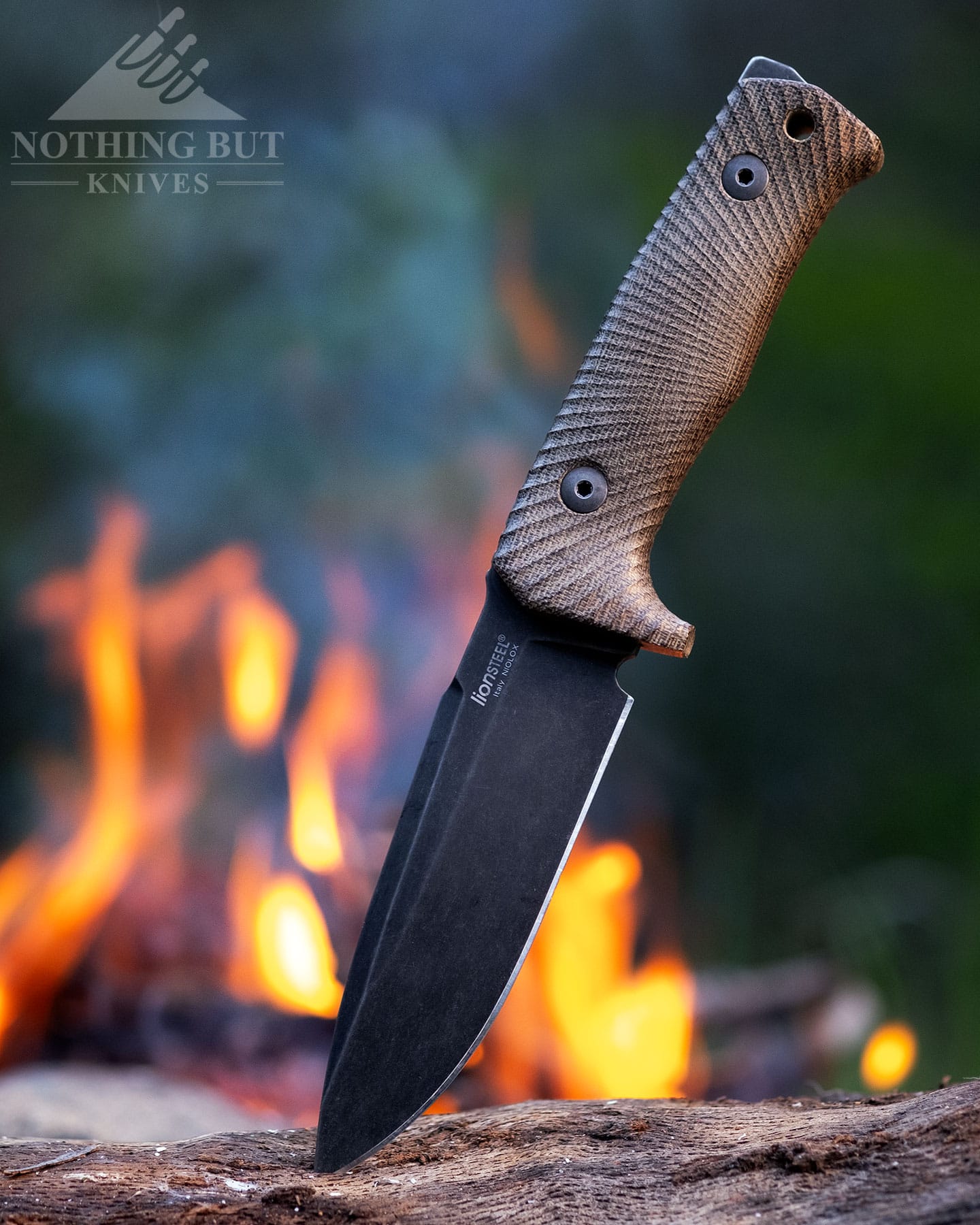
| Overall Length: | 9.92” |
| Blade Length: | 5.0” |
| Blade Steel: | Niolox |
| Blade Style: | Drop point |
| Blade Grind: | Flat |
| Handle Material: | Micarta |
| Sheath: | Leather |
| Made in: | Italy |
| Designer: | Michele Pensato (Molleta) |
The T5 is a hefty thing, but some of that weight leans into making it more useful, especially if you have some branch chopping to do. The overall durability of this knife is impressive. LionSteel did some nice work on the niolox steel, and the single-piece-Micarta handle does a lot, both for the comfort of the knife and the structural soundness of the design.
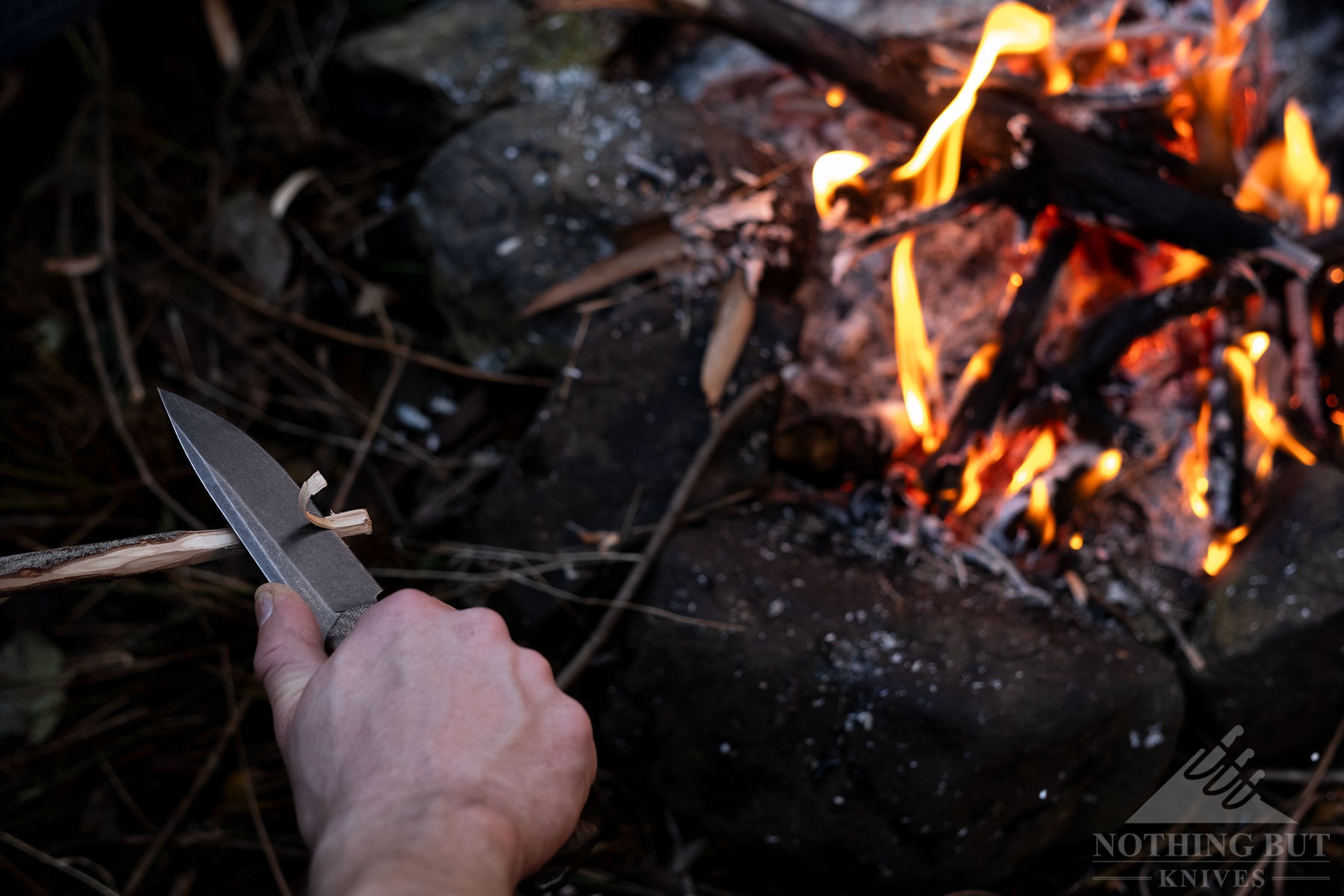
The balance of the knife is really what makes it stand out, though. It’s just a little bit blade-heavy, which helps it generate a lot of power on a swing and even makes batoning feel a little easier. Also, it comes with a leather sheath that’s MOLLE-compatible, which is kind of a rare sight.
Check out our review of the LionSteel T5 for more pictures and ramblings.
Toughest Pick – ESEE 4
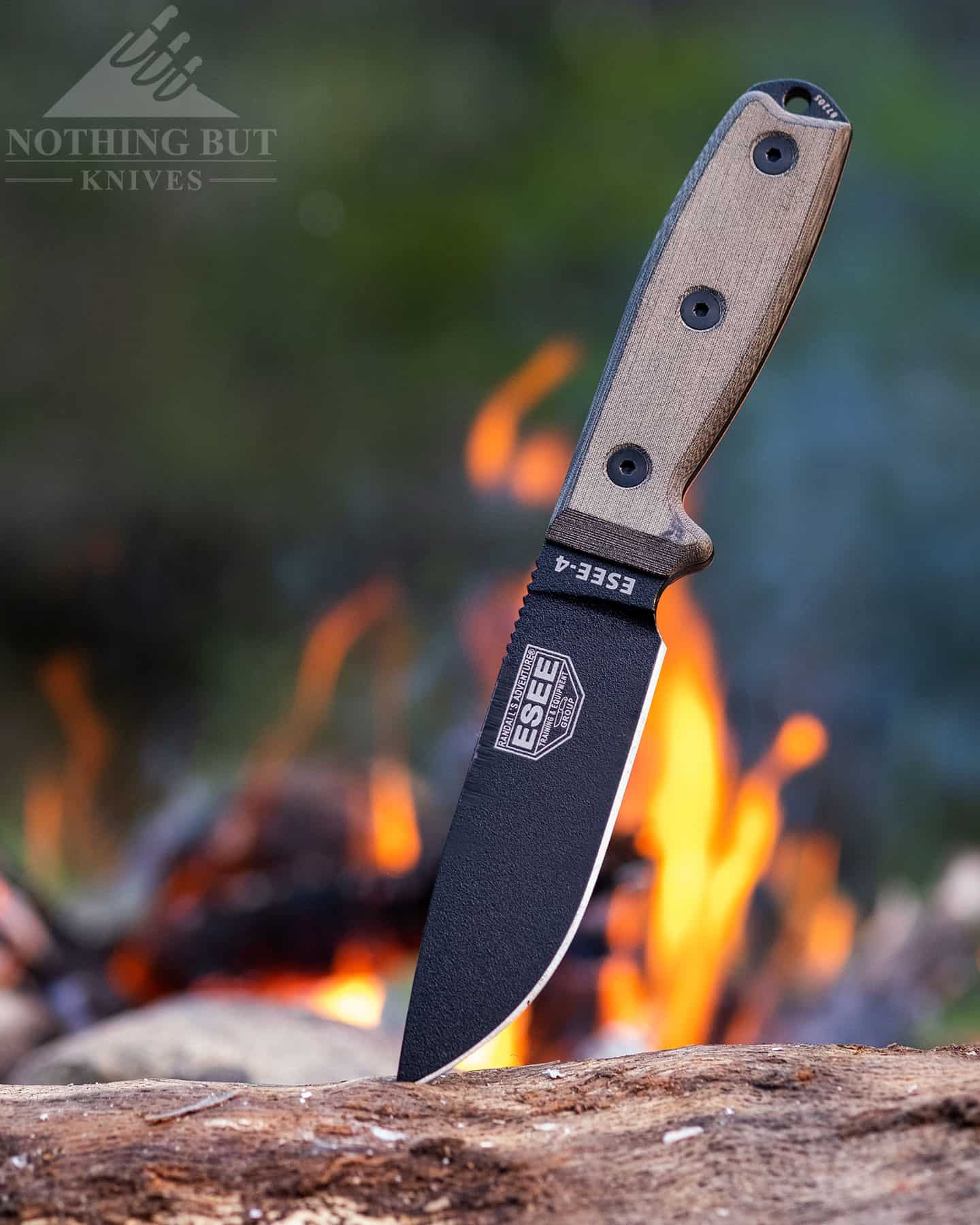
| Overall Length: | 9.0” |
| Blade Length: | 4.5” |
| Blade Steel: | 1095 |
| Blade Style: | Drop point |
| Blade Grind: | Full flat |
| Handle Material: | Micarta |
| Sheath: | Polymer w/ MOLLE back |
| Made in: | USA |
This is a bit of a pry bar with a good handle. I don’t exactly mean that in a bad way. ESEE tends to make their knives to be modified, and that includes the edge of the blade.
The ESEE 4 become the survival knife standard, though, and for good reason. The designers at Randall’s Adventure Training don’t put anything into production that they haven’t tested thoroughly in the field.
The ESEE 4 is probably one of the most versatile outdoor knives we’ve tested. The thick blade and thick edge can smash through a lot of work on a campground, and the handle has a mostly-neutral shape except for a bit of curvature that lets the hand nestle against the finger guard, so the knife feels secure in a lot of different grips.
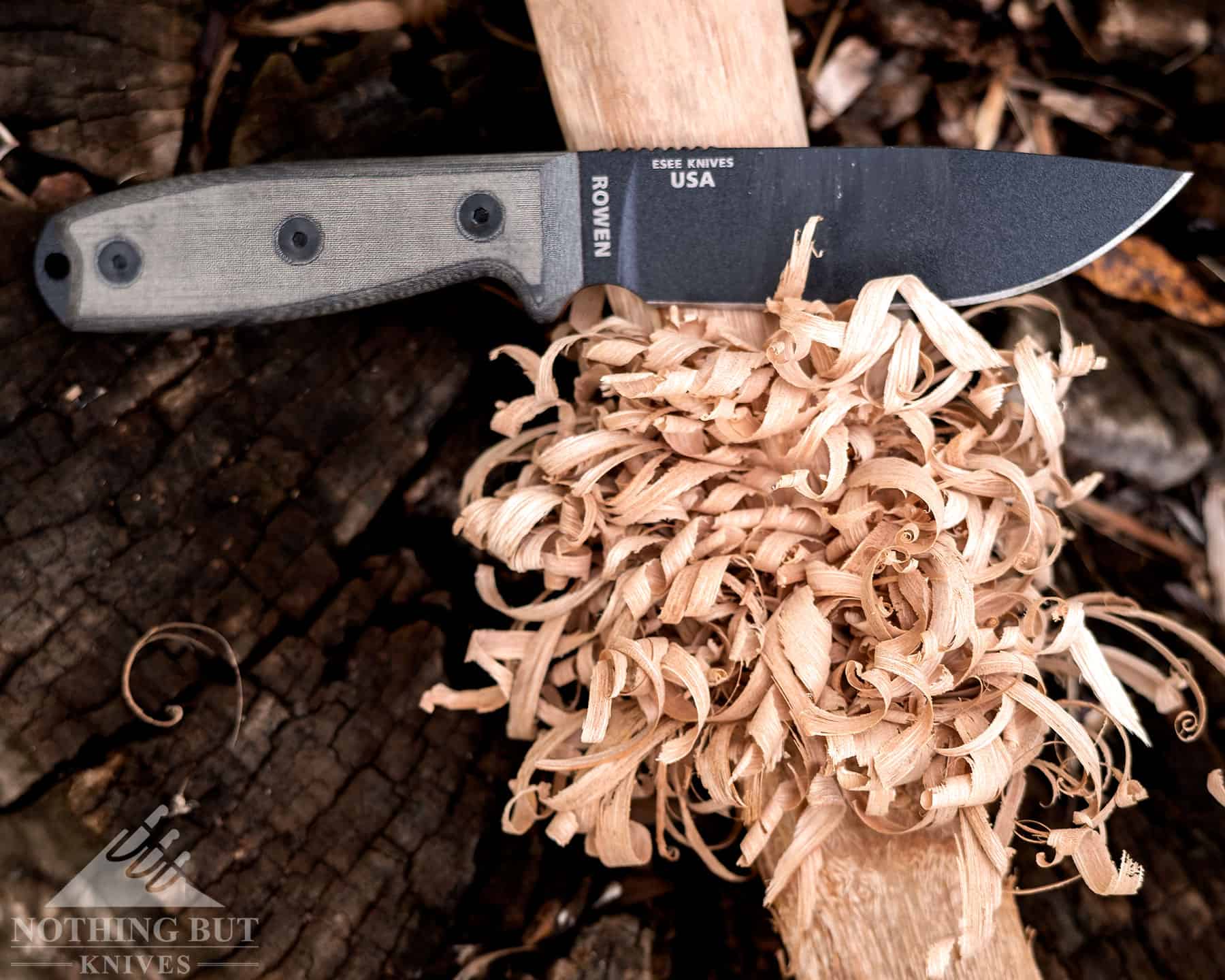
There are a few different sheath options for it, but the most helpful one is probably the nylon-backed version that’s MOLLE compatible. They also make this with 3D G10 handle scales, which fill the hand quite a bit better, but you don’t get the same fabric feeling of Micarta.
You can read a little more about it in our review of the ESEE 4.
TOPS Backpacker Bowie
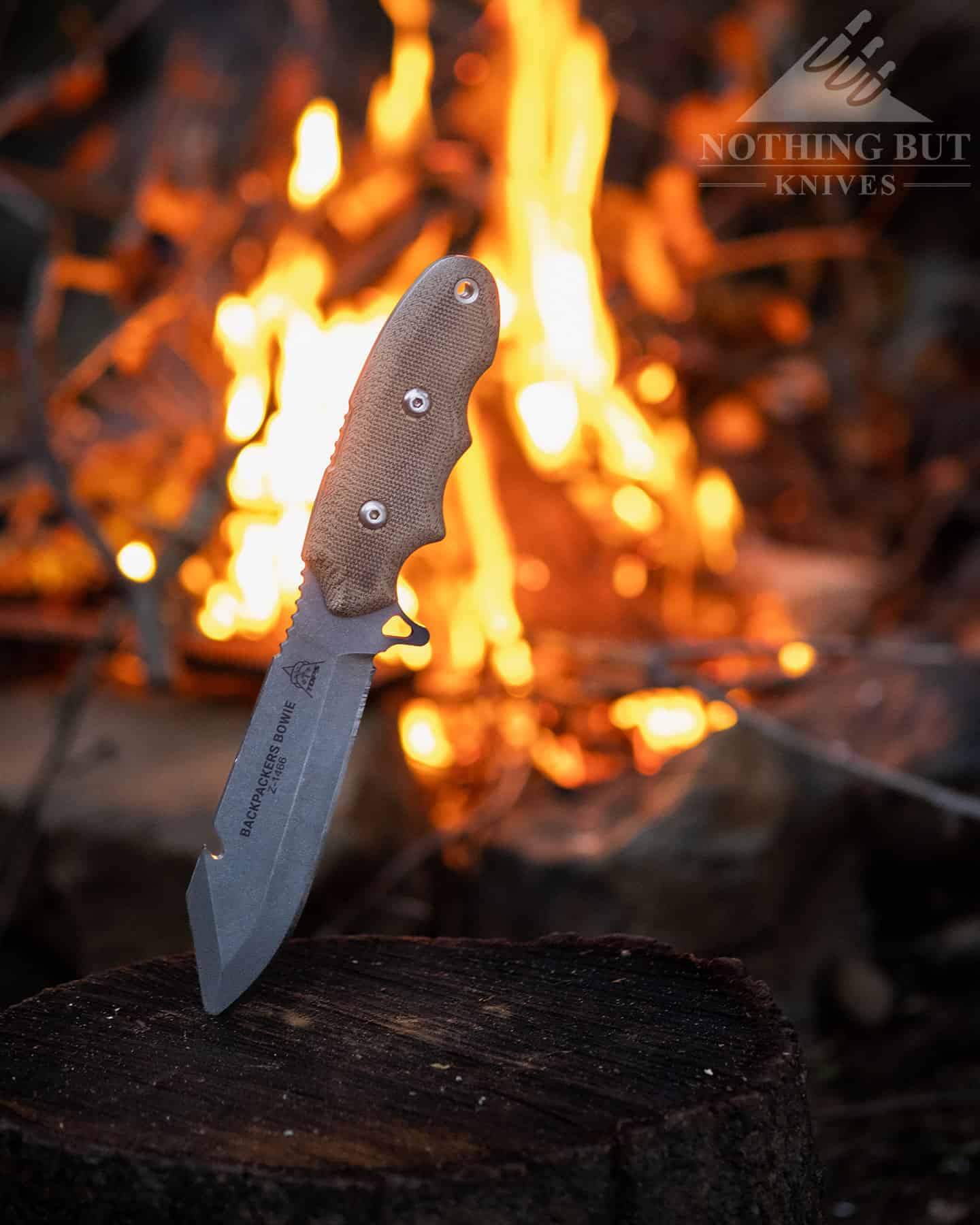
| Overall Length: | 8.375” |
| Blade Length: | 4.5” |
| Blade Steel: | 1095 |
| Blade Style: | Clip point |
| Blade Grind: | Flat |
| Handle Material: | Micarta |
| Sheath: | Kydex |
| Made in: | USA |
This is one of the few handles with a lot finger indenting in the shape that I still find comfortable. That’s partly thanks to the way the center of the handle curves out a little, putting the middle finger indent out a little farther than the others. It makes the grip feel a lot more natural, and between the finger guard and the Micarta scales, the grip is highly secure. Your hand won’t slip for anything.
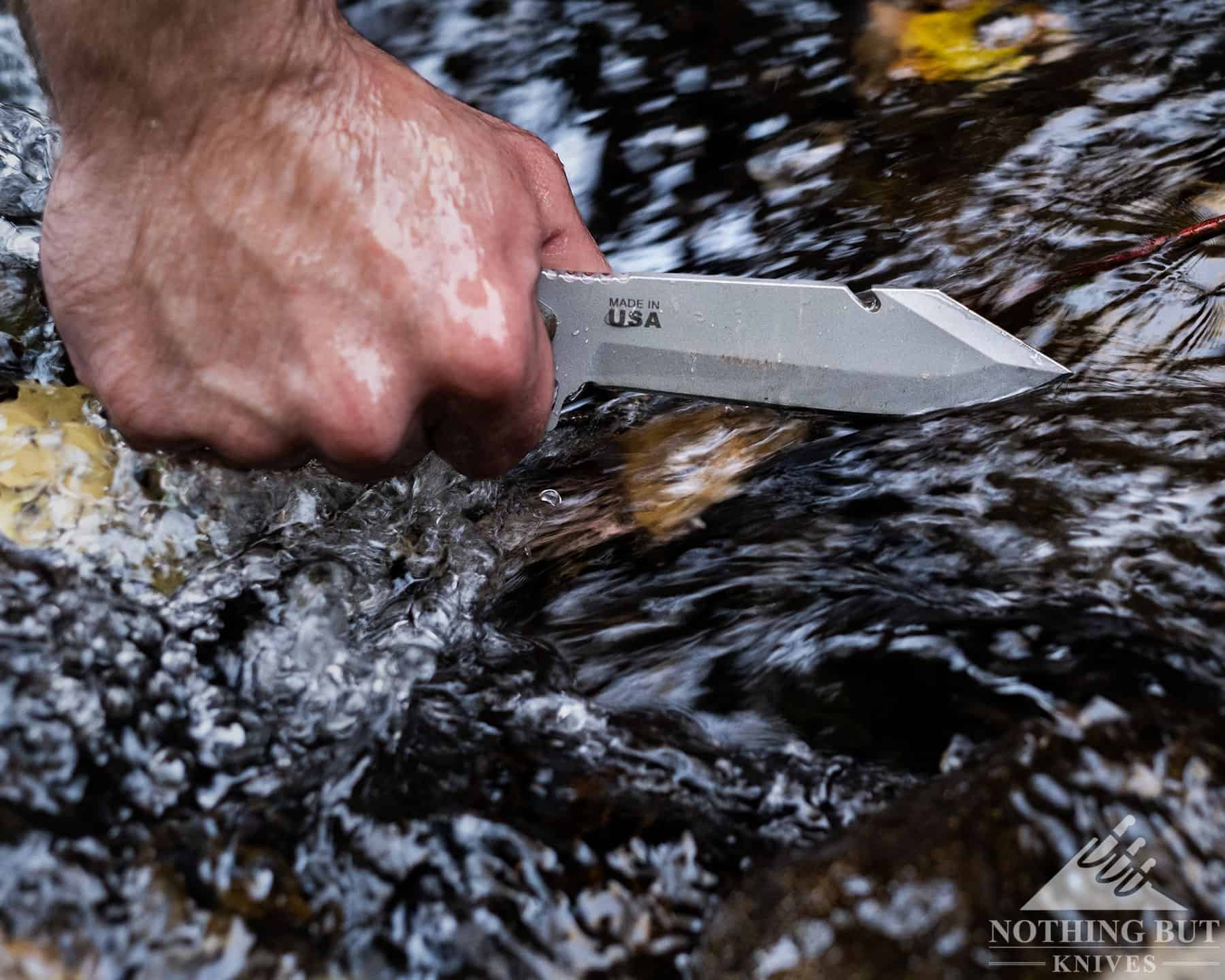
We’ve always appreciated having this thing around the campground. It’s light, but the blade-to-handle ratio keeps plenty of room between your hand and whatever you’re using the knife on. Usually we’re just using it to lift pots off the grill, poke at the fire, and carve up wood, but the design has widespread potential.
Best Budget Pick – Morakniv Bushcraft Black
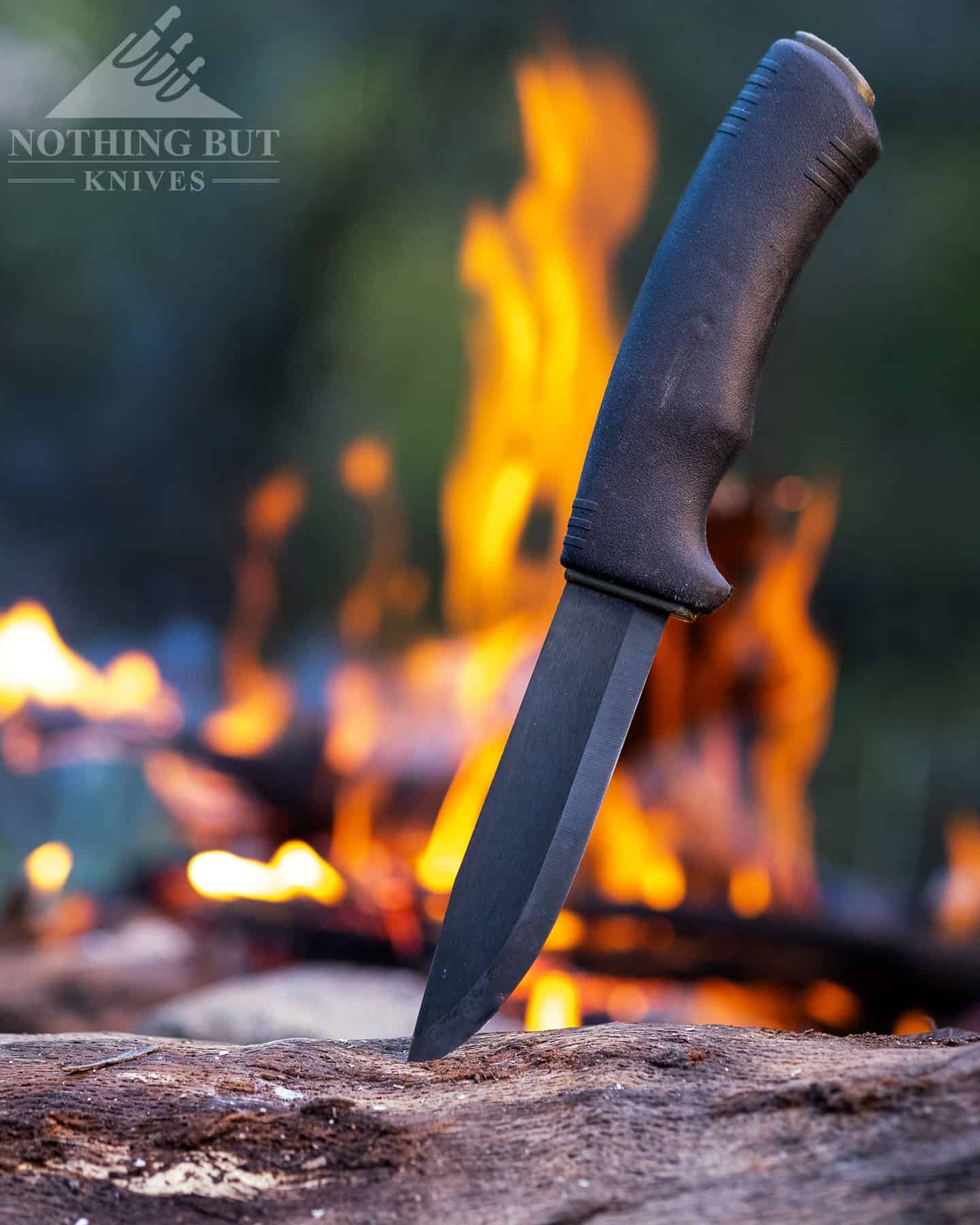
| Overall Length: | 9.25” |
| Blade Length: | 4.25” |
| Blade Steel: | High carbon |
| Blade Style: | Drop point |
| Blade Grind: | Scandi |
| Handle Material: | Rubber |
| Sheath: | Polymer |
| Made in: | Sweden |
Sometimes you just have to keep things simple, and it’s hard to get simpler than a Mora. Any Mora, really, but the Bushcraft Black is the one we’ve been putting through the ringer for many years.
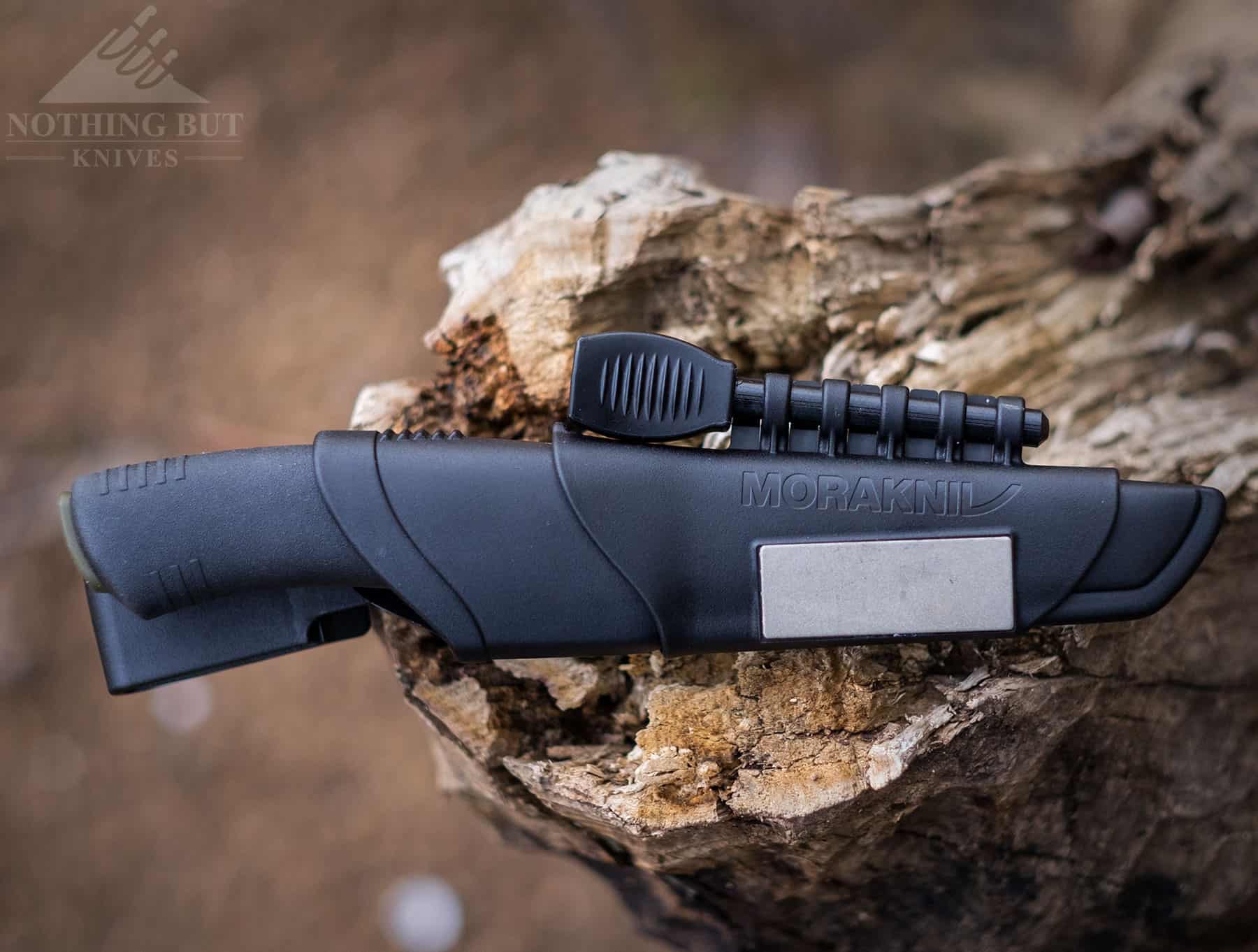
Obviously it was made specifically for bushcraft tasks, but we’ve found the grip ergos and the overall build to be solid enough to hold up to anything you’d try a survival knife on. Obviously there are certain situations I’d rather have a Ka Bar Becker in, but most of those knives will be at least double the price of the Bushcraft, and we’ve abused this knife enough to know that it can do everything we would need it to do, even in more dire survival situations.
The main drawback is that this ships with a very basic polymer sheath without a belt-carry system. There are plenty of aftermarket options to fix that, though.
If you are looking for a version of this knife that is full tang, and you don’t mind spending a little more, check out our review of the Morakniv Garberg.
Best Jungle Pick – Gerber Principle

| Overall Length: | 6.8” |
| Blade Length: | 2.9” |
| Blade Steel: | 420HC |
| Blade Style: | Drop point |
| Blade Grind: | Scandi |
| Handle Material: | Rubber w/ polymer inserts |
| Sheath: | Polymer |
| Made in: | USA |
The Principle feels a bit like Gerber’s version of a Mora Bushcraft or Companion. It has a short blade with a scandi grind that carves up wood and throws spark easily, and is somewhat reasonably priced. We’ve mostly put it in here as the best pick for jungle survival because the steel and handle materials make it highly corrosion resistant, but we’d still recommend packing something bigger along in that kind of situation.
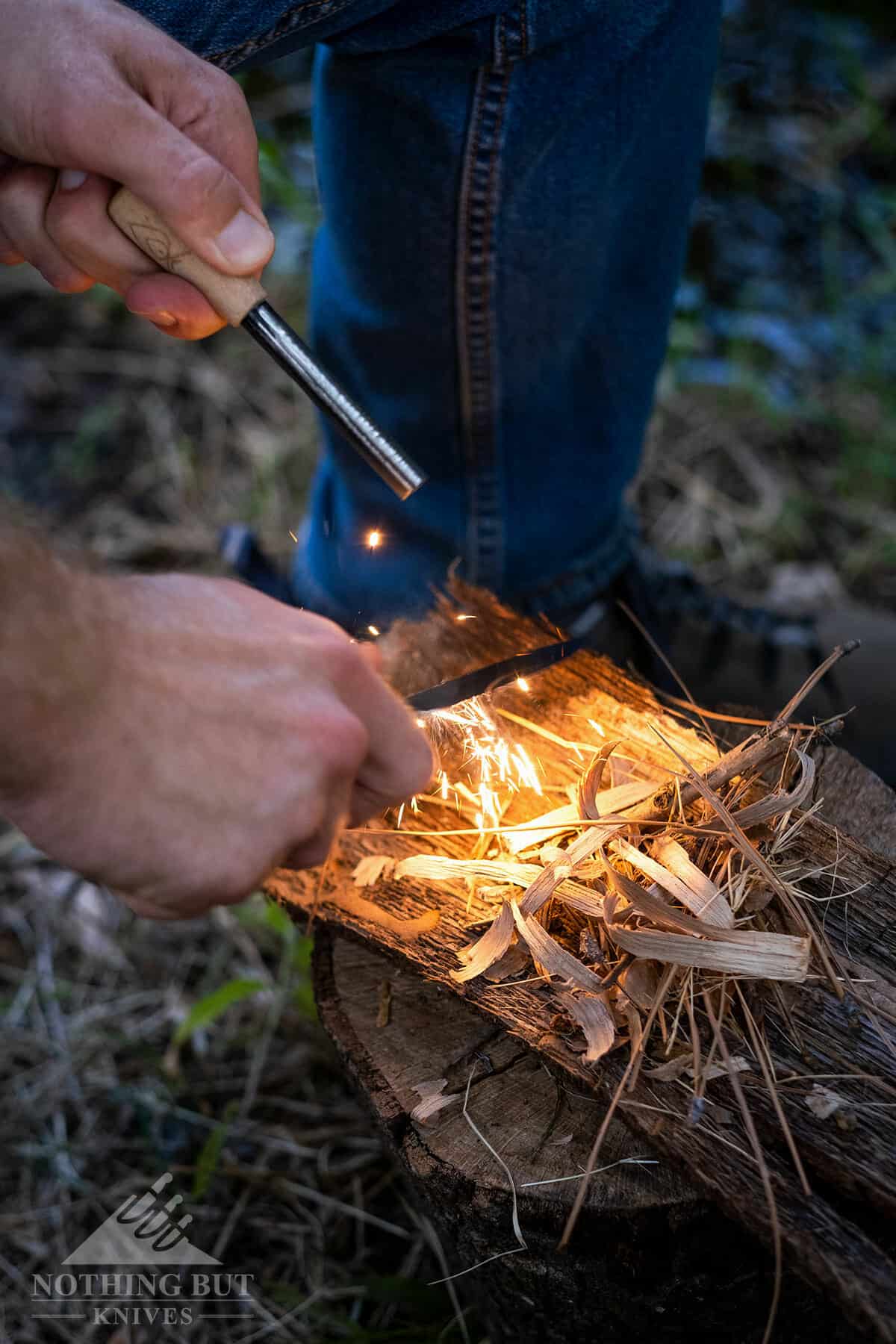
I love the handle on the Principle. This was the first knife that made me realize just how good Gerber is at making neutral handles that are easy to index. They’ve also placed some plastic bolsters at the top that make pinch grips feel a lot nicer. So in a lot of ways, this is more comfortable than most Moras.
The sheath is also a big perk of this knife. It’s MOLLE compatible in a very simple way that I’ve never seen done as well on any other knife. The whole thing runs on a plastic tab that you can pull and move to adjust the way the knife sits. It’s one of the more comfortable horizontal-carry knives in our collection.
You can read more about it in our full review of the Principle.
Best Small-Sized Pick – ESEE Izula II
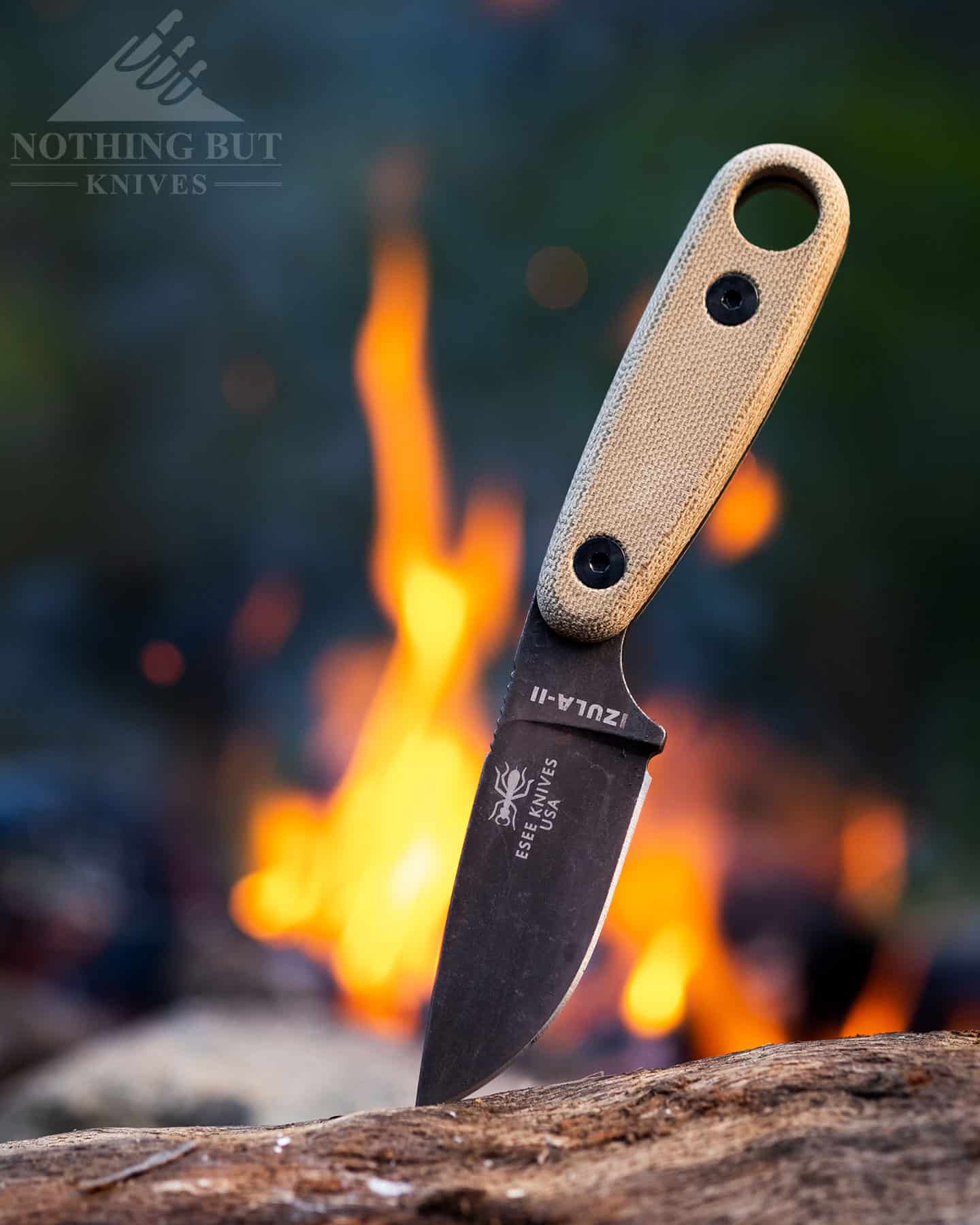
| Overall Length: | 6.75 |
| Blade Length: | 2.875” |
| Blade Steel: | 1095 |
| Blade Style: | Drop point |
| Blade Grind: | Full flat |
| Handle Material: | Micarta |
| Sheath: | Polymer |
| Made in: | USA |
Since this can be carried as a neck knife, the Izula II makes a capable backup tool, but it can do plenty of work if it’s the only thing you have in spite of the short blade.
It has a much slicier edge than most other ESEE’s (except for maybe the Pinhoti), and the handle has the kind of grippy texture and simple lines that make it firm in the hand and easy to draw. The sheath has a belt clip with a very strong retention, so it rides well pretty much anywhere on the belt, but it also has a big hole to run a cord or chain through if you want to go the neck-knife route.
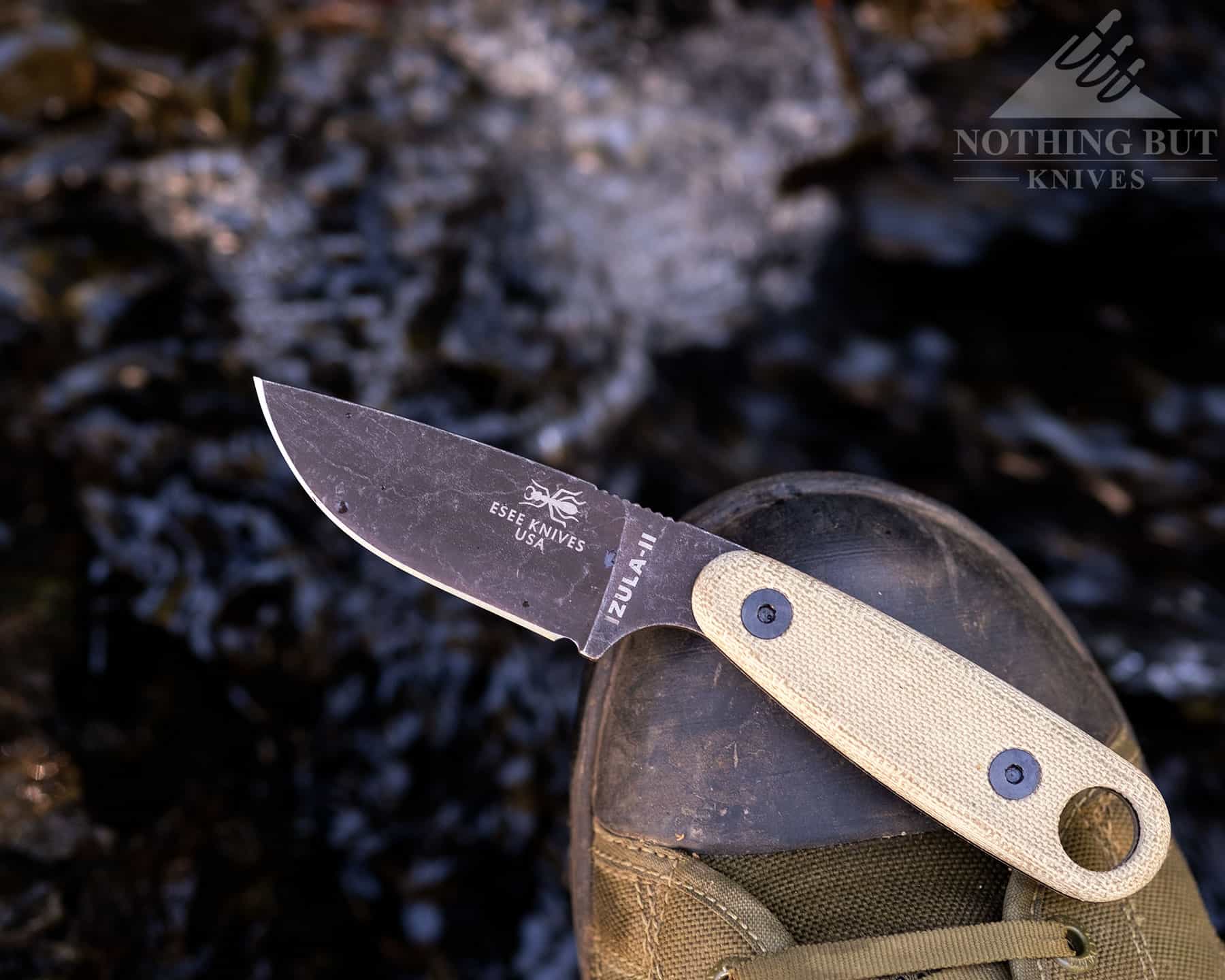
If you want something that’s shorter and lighter, you can get the original Izula. It comes skeletonized and with a shortened handle, but we’ve found that the extra weight of a slightly longer handle with Micarta scales is well worth it.
If you are looking for a slightly larger compact survival knife, check out the CRKT Bugsy. It is a great American made survival knife with a slightly larger blade.
Condor Mountaineer Trail Spur Wing Man
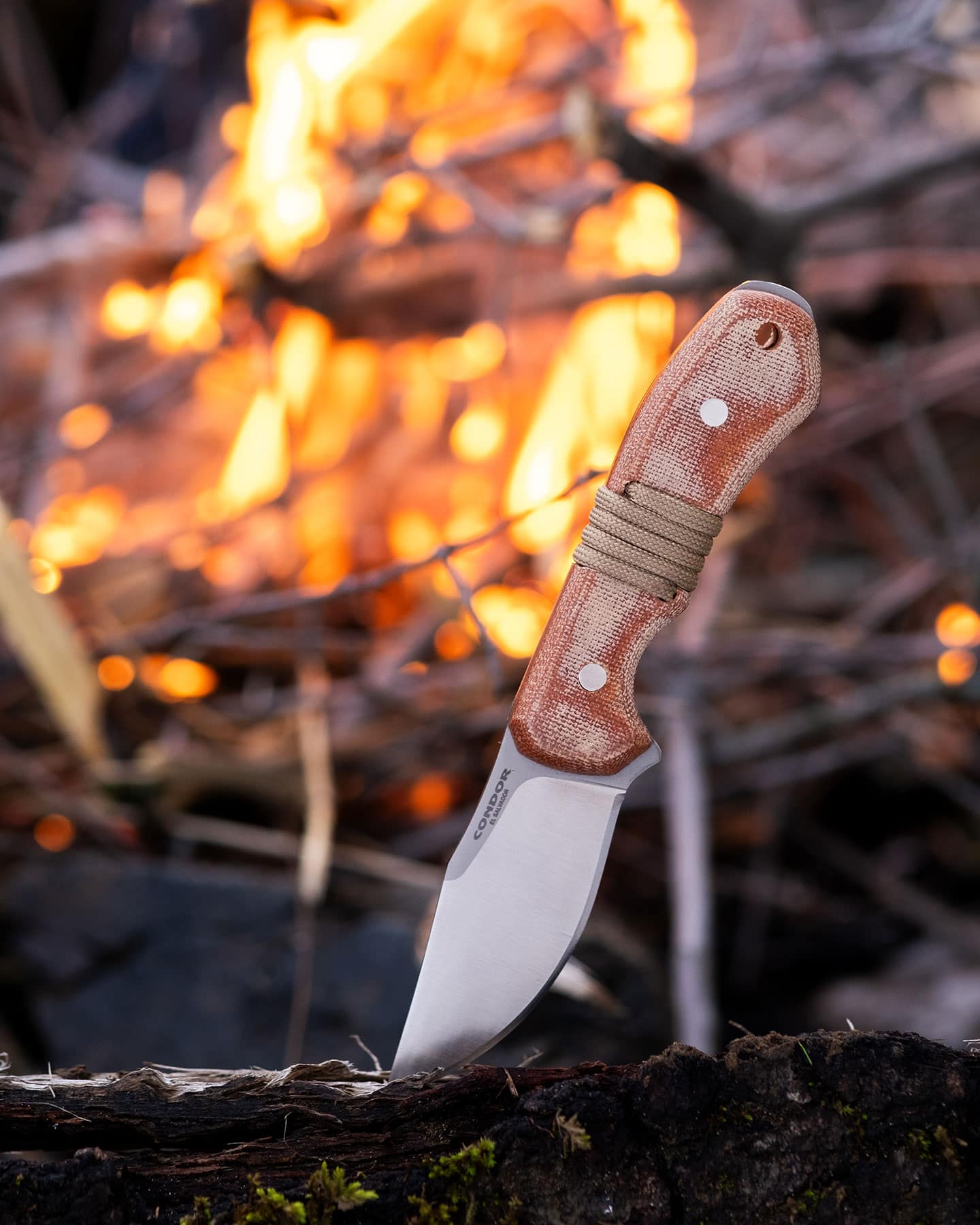
We are going to finish off this list with our first addition of 2024. This is a small survival knife with a big name. This versatile beast is a great option for any survival situation that requires carving. Of course, any real survival situation will require carving, so this knife seemed like an easy addition.
We liked the Mountaineer so much we included in both our Drunken Hillbilly Awards Article and our Drunken Hillbilly Awards Video.
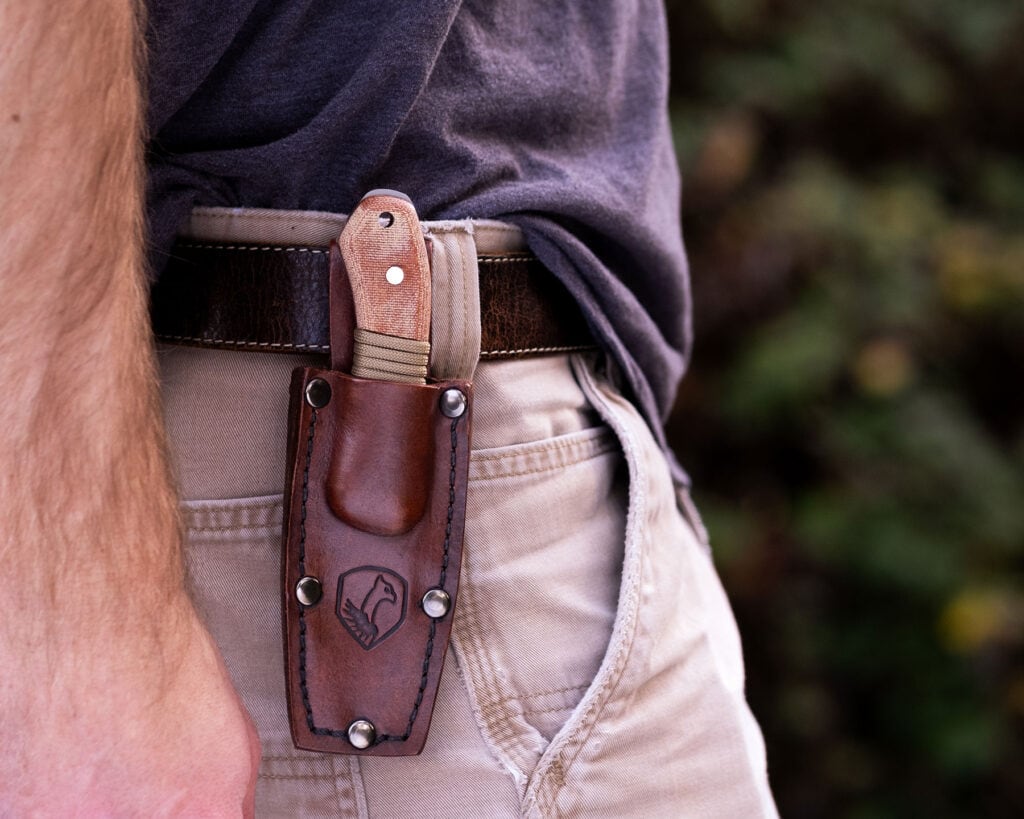
The handle of the Condor Mountaineer is surprisingly comfortable and grippy for a smaller fixed blade. The textured Micarta slabs offer plenty of friction and no hot spots.
The stylish leather sheath sits low and it makes one handed deployment and reinsertion quick and easy with minimal practice.
Survival Knife Video
We like survival knives so much, we made a video about a few of our favorites. Most of the material covered in the video is already covered in this article with the addition of some cool slow motion chopping and batoning shots and hillbilly cocktail mixing.
What is a Survival Knife
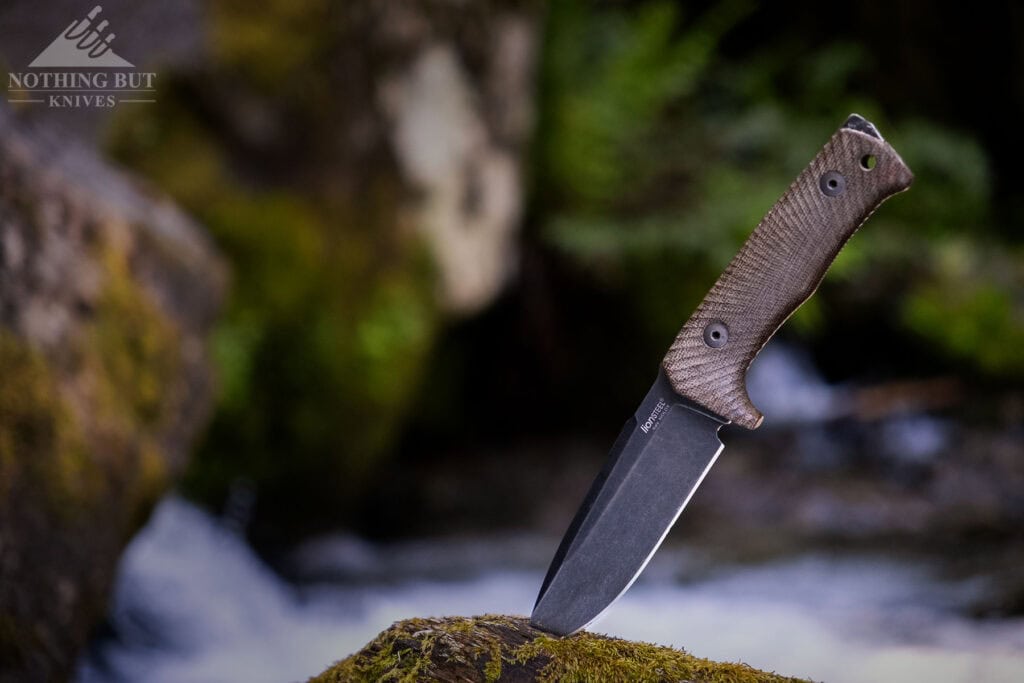
A survival knife is for when you’re in a situation and you want to get out of it as quickly as possible.
In most cases where people get lost in the wilderness, they’re found within a couple days. A survival knife is optimized for keeping you alive during those days. It’s all about fast work in quick emergencies. As such, there are a couple of key tasks it should be optimized for:
- Rough chopping and carving for fire and shelter
- Ability to spark off a ferro rod (or hard rock, if you can find one)
- Ability to carve wood for splints
- Ability to cut cloth for bandages
- Some ability to function as a tactical knife
How We Test Survival Knives
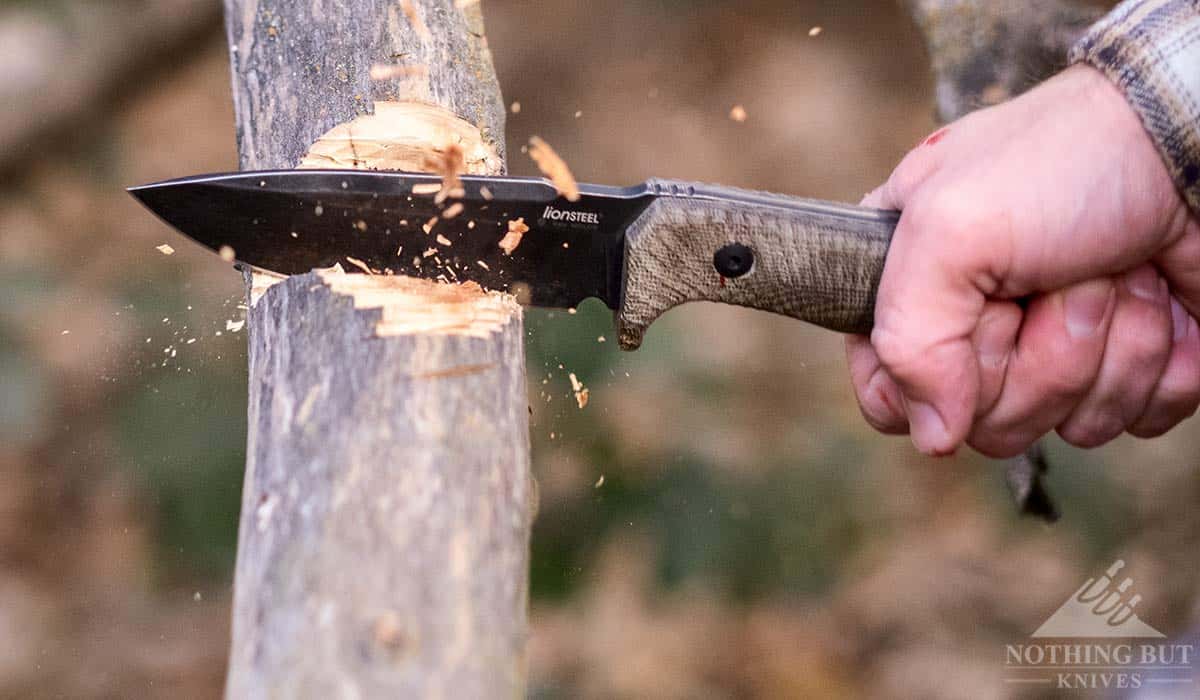
Our tests involve a lot of chopping, hiking, and fire making. We don’t put ourselves in danger all that often, but we do like starting fires and playing in the woods.
Usually we go into testing survival knives with a list of questions:
- Does the knife hold up to abuse?
- Can it start a fire?
- How well does it chop/carve wood?
- Does the sheath hold up to abuse?
- And is there anything about the knife or sheath that interferes with the tasks at hand?
We aren’t particularly good at building shelters, starting fires with knives, or making splints, but we can do all the things leading up to the parts that take skill. If we had an easy enough time chopping up wood into workable sizes, carving up feather sticks, and getting spark off a fire steel, we figure just about anyone reading this will have a good time of it too.
What’s Most Important in a Survival Knife
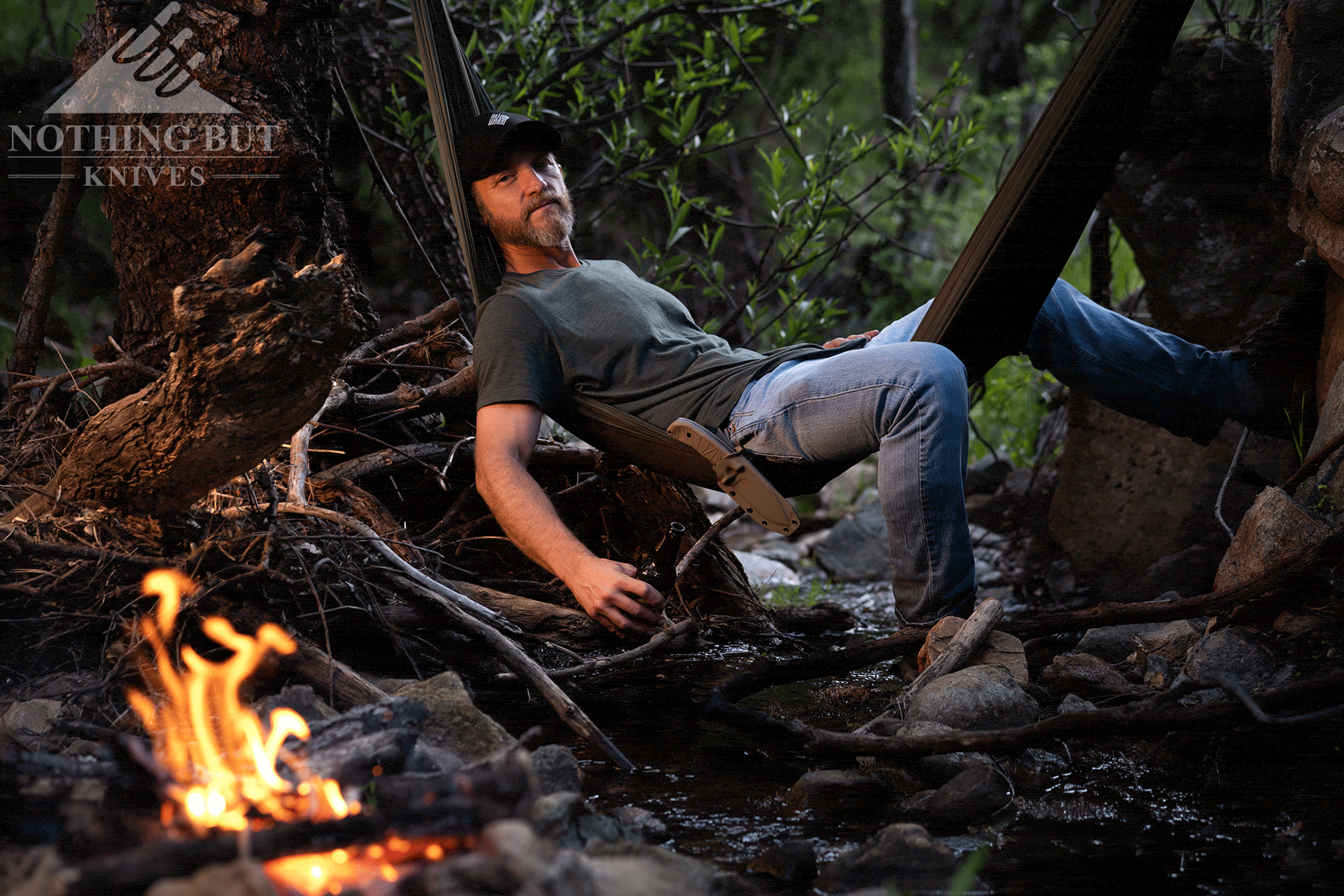
A lot of it depends on what situation and terrain you think you might need to survive in. We get into specifics like that in our knife choices, but here’s a quick breakdown of the features we usually prioritize while shopping for a survival knife.
Durability is probably king for survival knives
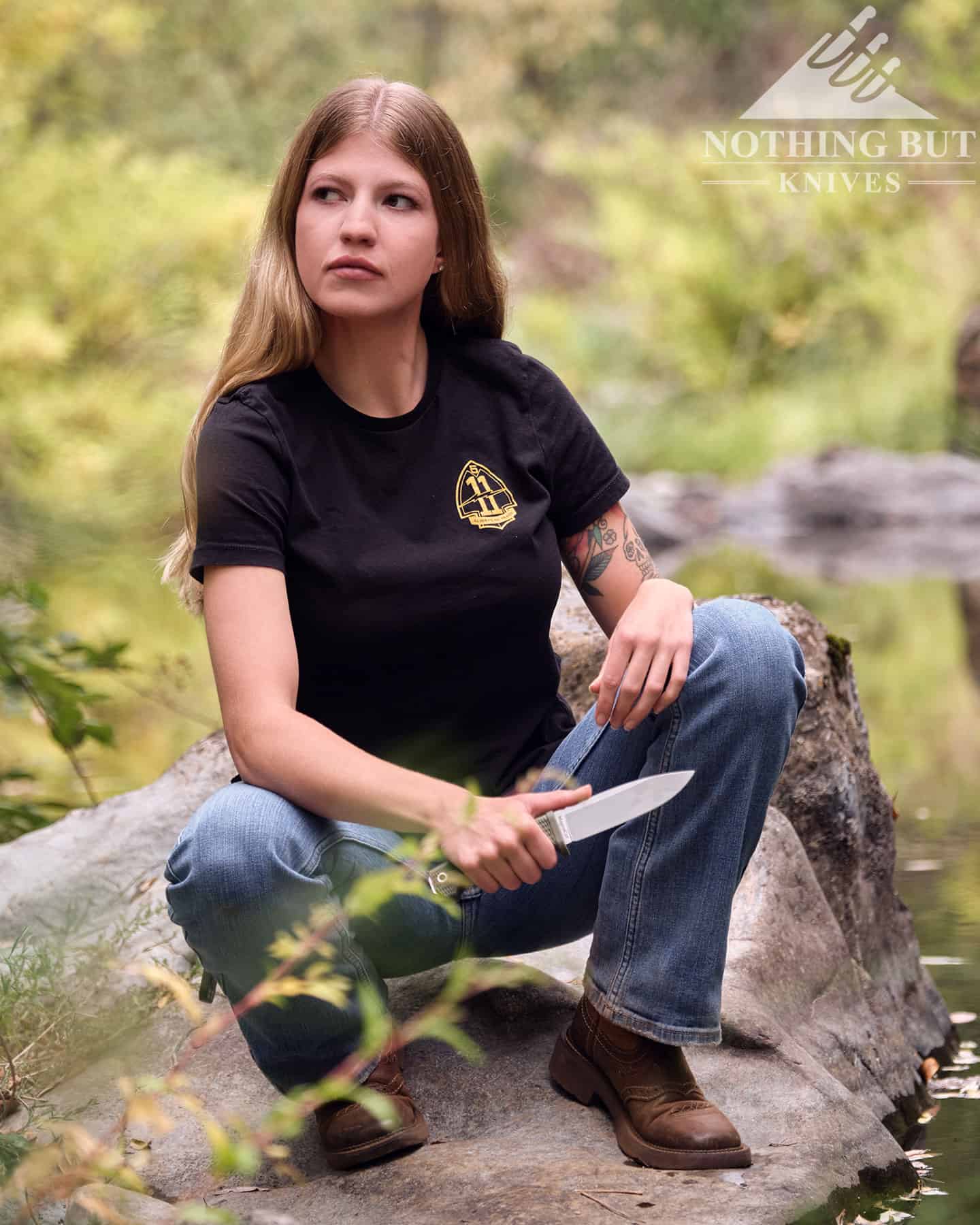
A good survival knife can hold up to being your only tool in a lot of different situations.
So long as the piece of steel can hold up and stay attached to the handle, you should be able to cut through brush, break down wood, and cut bandages just fine. With that in mind, you’ll usually want to look for knives with steel that prioritizes toughness over edge retention.
Here are some guidelines you can follow to help pick tougher knives out, but keep in mind there are exceptions to everything if the manufacturer knows what they’re doing.
| Full tang isn’t as important as you might expect these days (Just look at Mora), but it’s a good standard to keep to. |
| On cheaper knives it doesn’t hurt to get something with 3 rivets in the handle. |
| Synthetic or or cloth-based handles like G10 and Micarta are more stable and less prone cracking and swelling than natural stuff like wood and bone. |
| Flat or convex edges on the blade are ideal for both woodcraft and durability. |
| High carbon tool steels like 1095 are a good option if you know how to take care of it; it’s generally tougher but you have to keep it dry, which isn’t always easy in dire survival situations. |
| Stainless steels like CPM S35VN are great for keeping an edge and holding off rust, but they’ll be a lot harder to sharpen in the field. |
| Softer stainless steels like 420HC are easier to deal with and can be pretty tough, but often don’t have the same edge holding abilities of tool or powder steels. |
A good sheath is almost as important as a good handle
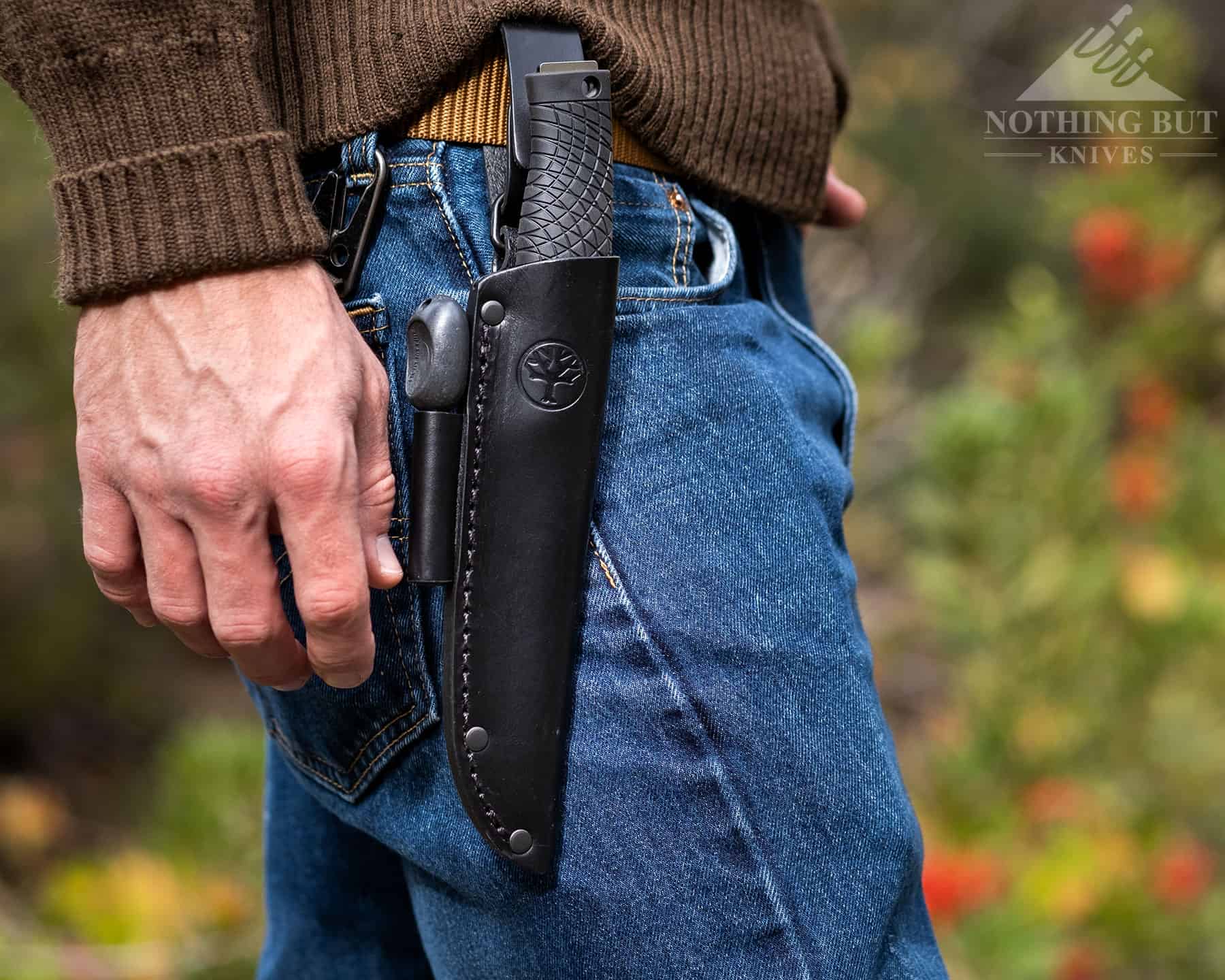
We generally prefer a kydex sheath with strong retention and a drain hole, but so long as it can keep that knife securely at your side it’s good enough.
Here’s a quick pros/cons run down based on our own experience:
| Leather sheaths: These usually ride well on the belt, and they always look good, but their durability is reliant on the stitching (look for double stitching for a really good sheath), and they usually aren’t as versatile as other kinds of sheaths. They’re often only set up for right-hand vertical carry (although there are exceptions like on the LionSteel T5). |
| Kydex/polymer sheaths: Often the most versatile and lightweight option, a good kydex sheath can make a knife capable of sitting anywhere on your body if the manufacturer has shaped and placed the holes and slots well. The main downside is that the hard nature runs a risk of dulling a blade’s edge after several cycles of drawing and sheathing. |
| Nylon sheaths: These tend to sit somewhere in between leather and Kydex for versatility. It’s lighter than leather and more forgiving than Kydex, but it doesn’t have much rigidity on its own. You rarely see this used as the only material in a knife sheath. Even when a whole sheath appears to be nylon it usually has a plastic cover inside to keep the blade from cutting the sheath open. More often nylon is used as a backing for Kydex to form the belt loop. |
One big feature you want to look out for is whether a sheath is compatible with a Tek Lok (we usually mention whether a knife is in the description), or if there’s any mention of a MOLLE system. Those two features usually mean the sheath has a well-thought-out system that you can rely on.
Geometry cuts
A reasonably sharp edge with a flat or convex grind can do wonders in the wilderness. A blade doesn’t always have to start out sharp so long as it can carve up some wood for a couple days without the edge chipping or deforming.
There are a couple of hollow-ground exceptions, though, like the Cold Steel SRK. That knife is plenty tough enough thanks to the steel and thickness, but edge geometry should keep it cutting a little better for a longer period of time, so that’s worth keeping in mind.
How is a Survival Knife Different from a Bushcraft Knife
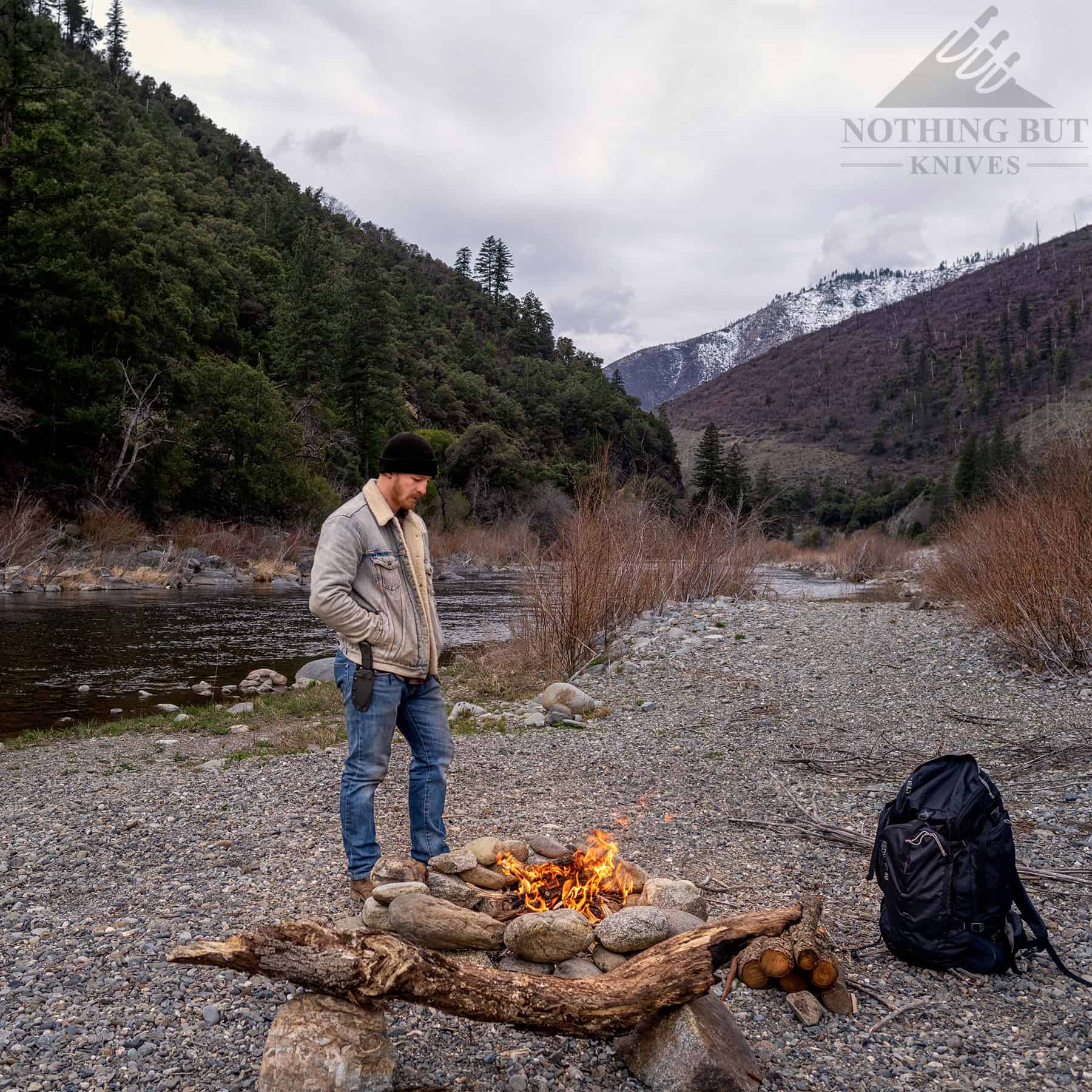
A bushcraft knife is about thriving in nature, not just surviving, while a survival knife is made more generally for emergency situations. In one, you’re settled in for a few days and can afford the time to make intricate traps and shelters. The other assumes you’re in a situation you really don’t want to be in, and you want to get out as quickly and safely as possible. One particularly good description we’ve heard a few times from people like David C. Anderson is that a survival knife is just a bushcraft knife and a tactical knife blended together. A good survival knife is capable of building an outdoor shelter, but a good bushcraft knife would usually be the better option.
All that said, there’s enough crossover between “surviving” and “thriving” in knife design language that most knives in one category are plenty functional in the other. But where a survival knife should be able to chop up a few branches to make a quick lean-to shelter and create some spark to light a fire, a bushcraft knife should actually be able to do some finer carving. There should be an element of tool making and comfort with it. The design of a bushcraft knife can assume that you came a little more prepared for a situation, so it’s not as important that it can start a fire easily.

NBK’s knife review site has been one of the better sites I’ve visited over the past few months. Andrew North is an accomplished writer with a solid technical and experienced perspective on everything knives. I thoroughly enjoyed his learned descriptions of each knife reviewed. Great work!
I don’t know about “accomplished” but I appreciate you reading, Phil.
I love my esee 5, tough as a tank, and can accomplish all tasks I need.
You overlooked Pohl Force from Germany and Extrema Ratio from Italy. Those countries have been making edge weapons long before America was a glint in the eye of Columbus.
We didn’t overlook them; we just haven’t had the chance to test knives from those companies. You can’t blame us too much, though, since, going by the logic of your weird Columbus statement, those companies won’t even exist until we discover them.
Mr. A. North, it was Amerigo Vaspucci (mat have misspelled some or of his name) that discovered what we call the Americas today. Vikings and Indians did a bit of landing and colonizing as well.
Well there it goes; the whole basis of my bad joke just sailed away to new lands.